Presentation Skills Training - Online Public Speaking Courses | Rule the Room Today!
Rule the Room is here to help improve your presentation skills. Jason Teteak's custom training courses are perfect to improve your public speaking skills today!

Discover Your Presentation Personality Are you a Fascinator, Inspirer, Performer or Energizer?

August 18, 2020 Jessica Teteak

These days you hear a lot about authenticity.
Because knowing your style is the quickest way to build trust and connect with anyone, including audiences great or small … click here to take our Presentation Personality quiz and find out if you are more a Fascinator, Inspirer, Performer or Energizer.

Our goal is to give you practical and actionable tools that create real connections with your audience. So you can rise to the occasion and shine when it counts!
So, are you more the most “you” when you are fascinating, inspiring, performing or energizing?
F-Fascinators shine brightest when they are sharing data.
They can be themselves by sharing wisdom and information that convinces and reassures the audience they are reliable sources.
Here are top traits of Fascinators:
- They endear with their wisdom.
- They excel at planning.
- They are encouraging.
- They are good audiences.
- They enjoy getting others to perform.
- They enjoy watching others have fun.
- They enjoy sharing trivia.
One audience member once told me after watching a presenting fascinator, that they seemed to anticipate every question even before it was asked and was prepared with an immediate answer. Fascinators offer their knowledge and wisdom in a way that makes the audience feel they are in the most capable hands.
Take a look at this clip from our Archetype program, which can be found in our PS Lab . Jason shares more details on what it means to be a Fascinator, and you’ll also get to see a Fascinator in action during an actual presentation.
I-Inspirer’s shine brightest when they share their spirit.
Inspirers endear with their spirit. They use their intuitive and caring nature to meet needs. This makes an audience feel safe. Their storytelling ability and their talent for conjuring up the perfect story to make a point makes the audience feel good.
Here are top traits of Inspirers:
- They endear with their spirit.
- They build rapport easily and on the fly.
- They are flexible and adaptable.
- They enjoy sharing their feelings with the audience.
- They are naturally caring.
- They read people easily.
- They enjoy sharing stories.
If you’ve been part of the Rule the Room community, you’ve seen an Inspirer in action all over the website – Jason is an Inspirer!
Inspirers demonstrate their empathy by telling stories to which the audience can relate.
Here’s another clip from our Archetype program, which can be found in our PS Lab . Jason shares more details on what it means to be an Inspirer, and you’ll also get to see an Inspirer, other than Jason in action during an actual presentation.
P-Performer’s shine brightest when they have a crowd to entertain.
Performers endear through entertaining others. They love the spotlight and use their body language, their voice, and their words to physically model key concepts and explanations. They can express ideas in a way that makes the audience feel safe, and they can engage an audience with their whole being to make it feel good. Here are top traits of Performers:
- They endear via entertaining.
- They can perform spontaneously.
- They love the spotlight.
- They get others to crave their performance.
- They can get others to laugh.
- They enjoy and feed off laughter.
- They are great at relating to an entire audience.
A Performer friend was the best man at his friend’s wedding. He began his speech at the groomsmen’s table, but within three minutes he had moved to the center of the tent, and during his speech he managed to make a 360-degree rotation so that eventually he had faced everyone in the room. He recited a poem, using his body and voice to maximize the impact, and he improvised as he went along. In fifteen minutes, he made everyone smile and feel good, and he got a rousing ovation.
Take a look at how another Performer uses his charisma and bogy language to engage his audience.
E-Energizer’s shine brightest when they share their courage.
Energizers endear with their courage. They have an ability to build up the audience’s confidence and fire them up with energy to go out and get something done. This makes the audience members feel safe and good.
Here are top traits of Energizers:
- They endear with their courage.
- They welcome competition and challenges.
- They hold passionate beliefs.
- They have innate leadership qualities.
- They have a powerful presence.
- They enjoy pumping up a crowd.
- They are fond of puns.
Many excellent sports coaches are Energizers. They boost morale with halftime talks that make their teams feel good.
Take a look at this Archetype clip, as Jason shares more details on what it means to be an Energizer, and you’ll also get to see an Energizer in action during an actual presentation.
Discovering your presentation personality is the first step to becoming a more genuine, more authentic public speaker. Once you know your style, you can leverage the techniques and traits above to keep your audience engaged, and have them feeling safe with you as a presenter.
To learn more about how you can use your presentation personality style, check out the Public Speaking Lab for just $1 and get started feeling more like yourself with your public speaking–your audience will love it! We’ve recently added a few more programs that we think you will really enjoy!

About Jessica Teteak
Jessica Teteak is the Co-Founder of Rule the Room Public Speaking, Director of Creative Services and Presentation Coach. As a copywriter, editor and author she knows the power of finding your “voice” and words well spoken.
Jessica is an Energizer and a dynamic encourager. Her years spent coaching in Athletics, as a Fitness Professional and through Entrepreneurial ventures developed her holistic, unique approach to Public Speaking and Build Your Business Presentation Coaching.
Work with her ONLY if you’re ready to break the mold and lean more towards a “Jobs” presentation than a “Gates”. (And yes, she is Jason’s wife and coach.)
Strengths Finder: 1. Communication 2. Individualization 3. Activation 4. Belief 5. Woo
- SUGGESTED TOPICS
- The Magazine
- Newsletters
- Managing Yourself
- Managing Teams
- Work-life Balance
- The Big Idea
- Data & Visuals
- Reading Lists
- Case Selections
- HBR Learning
- Topic Feeds
- Account Settings
- Email Preferences
What It Takes to Give a Great Presentation
- Carmine Gallo

Five tips to set yourself apart.
Never underestimate the power of great communication. It can help you land the job of your dreams, attract investors to back your idea, or elevate your stature within your organization. But while there are plenty of good speakers in the world, you can set yourself apart out by being the person who can deliver something great over and over. Here are a few tips for business professionals who want to move from being good speakers to great ones: be concise (the fewer words, the better); never use bullet points (photos and images paired together are more memorable); don’t underestimate the power of your voice (raise and lower it for emphasis); give your audience something extra (unexpected moments will grab their attention); rehearse (the best speakers are the best because they practice — a lot).
I was sitting across the table from a Silicon Valley CEO who had pioneered a technology that touches many of our lives — the flash memory that stores data on smartphones, digital cameras, and computers. He was a frequent guest on CNBC and had been delivering business presentations for at least 20 years before we met. And yet, the CEO wanted to sharpen his public speaking skills.
- Carmine Gallo is a Harvard University instructor, keynote speaker, and author of 10 books translated into 40 languages. Gallo is the author of The Bezos Blueprint: Communication Secrets of the World’s Greatest Salesman (St. Martin’s Press).
Partner Center
Tailor Your Presentations to Personality Types: Tips&Tricks!
Have you heard it before? Your presentation must be tailored to your target audience to be successful. That’s correct. But have you ever taken a closer look at who your target audience really is, beyond just looking at the usual data? Psychological aspects can also have a significant influence on the success of your content.
Today, we introduce you to different personality types, explain how they can help in the context of presentations, and how you can skillfully align your presentations with your audience.
Why do you need to know your target audience?
Understanding the target audience is crucial for the success of a PowerPoint presentation. An audience is composed of individual personality types, each with different needs, interests, and preferences . To make your presentation and content successful, it is essential to tailor them to these specific needs and interests.
To learn how to conduct a target audience analysis, read our article on “ Target Audience Analysis. “
To create an impactful presentation, it is essential to delve into the potential audience beforehand. Only through a well-founded understanding of the different personality types can the presenter tailor their message effectively to the audience’s needs, engaging them and generating enthusiasm for the content.
Analyzing the personality types of the audience can provide insights into the most effective types of content , examples, and visual aids to capture the audience’s attention and interest.
By knowing the types, you can guarantee a more individualized approac h that appreciates the audience’s diversity and uniqueness, leading to a more positive impact.
Handling the different personalities with empathy not only contributes to the audience’s attention and positive response but can also establish a deeper connection and strengthen trust in the presenter.
What are personality types?

Every individual is different, meaning that each person has their own personality traits . These traits play a central role in interactions between people and significantly influence their perception, reactions, and decisions.
Due to the diversity of personalities, various theories in personality psychology attempt to develop typologies to describe and classify the variety of individual characters. The idea behind this is to identify certain behavioral patterns, traits, and preferences that are typical for specific groups of people. Such typologies can be of great use not only in psychology but also in other areas like communication and presentation to better understand the audience’s behavior and needs.
Various Personality Models
Over time, psychology has developed different models to describe these personality traits and categorize them into typologies. Here, we introduce the most well-known models:
The Myers-Briggs Type Indicator (MBTI)
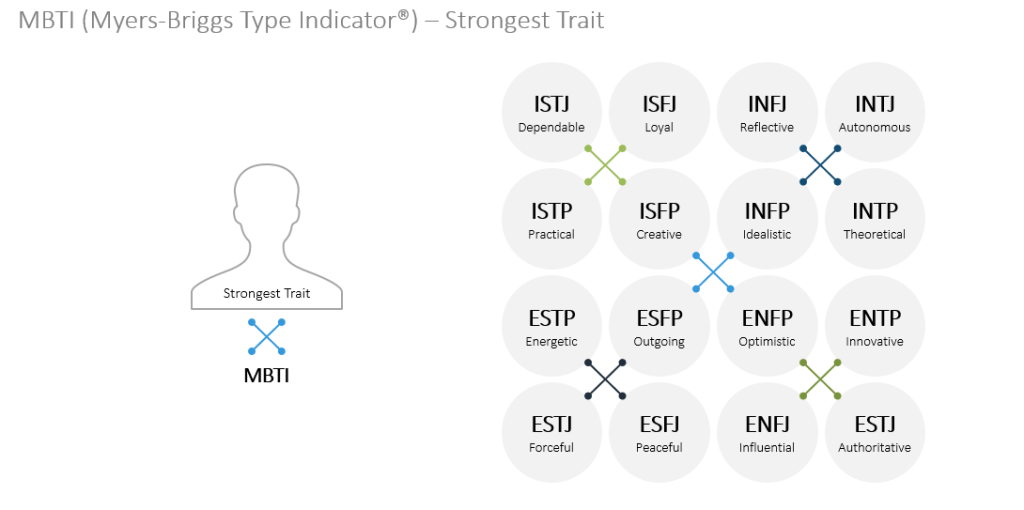
One well-known typology is the Myers-Briggs Type Indicator (MBTI), which classifies personality based on four dimensions.
The model divides people into 16 different personality types, each represented by four letters:
• Extraversion (E) or Introversion (I)
Describes where individuals feel most comfortable. Extraverted individuals are sociable and gain energy from interacting with others. Introverted individuals, on the other hand, feel more comfortable in quiet, withdrawn situations and gain energy through self-reflection.
• Sensing (S) or Intuition (N)
Describes how people perceive and process information. Sensing types prefer concrete facts and information perceived through their senses, while intuitive types are more interested in abstract ideas and connections and rely on intuition and imagination.
• Thinking (T) or Feeling (F)
Describes how decisions are made and how emotions are handled. Thinking types prefer a rational and logical approach, orienting themselves around objective criteria. Feeling types, however, place more emphasis on emotions and empathy, often making decisions by considering others’ feelings.
• Judging (J) or Perceiving (P)
Sheds light on how people interact with their external environment and organize information. Judging types prefer structure, planning, and organization and tend to make decisions and complete tasks. Perceiving types, on the other hand, are more flexible and spontaneous, keeping their options open to adapt to new information.
The model aims to help understand individual preferences and behaviors and is commonly used in personality development, teamwork, and career choices. Deeper information can be found here .
Regarding presentations , the model can provide insights into decision-making processes, information absorption, and how emotions might influence potential purchases.
The Big Five Model
The Big Five Model is a personality psychology that describes five fundamental personality dimensions:
- Neuroticism
- Extraversion
- Openness to Experience
- Agreeableness
- Conscientiousness
The model aims to capture and understand individual differences in these dimensions. It is frequently used to examine personality traits, make predictions about behavior, and has applications in various fields such as psychology, organizational development, and human resources.
Regarding presentations, the Big Five Model can be useful in several ways:
It gives insights into the personality traits of the audience, providing a better understanding of the target audience. This enables a targeted adjustment of the presentation to better accommodate various needs and preferences.
You can tailor your content based on the audience’s interests and preferences , making your presentation more relevant, engaging, and attention-grabbing. It can also be helpful in handling questions and feedback . By better understanding personality types, you can respond appropriately to questions or feedback, fostering positive interactions.
The DISC Model
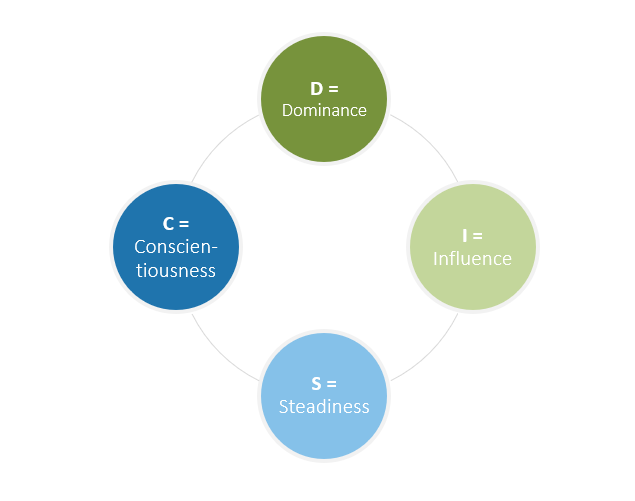
The DISC model categorizes people into four main types :
• D (Dominant)
Individuals with the Dominant type are characterized by their assertiveness, determination, and goal orientation. They are often decisive, confident, and determined. People with this personality prefer clear structures and quick results and tend to like taking control.
• I (Influence)
Here, we have extroverted, enthusiastic, and social individuals. Influential persons are often charismatic, communicative, and sociable. They enjoy being in the spotlight and motivating others. Influence types are usually optimistic and tend to be attracted to new ideas and challenges.
• S (Steadiness)
The Steadiness type is calm, patient, and team-oriented. They are empathetic, loyal, and reliable. They prefer a harmonious environment and work well in cooperative teams.
• C (Conscientious)
Conscientious types are precise, detail-oriented, and analytical. Individuals of this type place great importance on accuracy, quality, and thoroughness. They are often well-organized and responsible. Conscientious personalities have high standards and work diligently and precisely.
In the context of presentations , the model can help you understand your audience’s behavior and needs and adapt your presentation accordingly. It contributes to making your PowerPoint presentations more effective, targeted, and engaging.
The Enneagram Model
The Enneagram model describes nine different personality types , each represented by a number from 1 to 9. The model shows how the nine types are interconnected and how they differ in their thinking, feeling, and behavior. Behavior patterns become clearer.
Regarding presentations , the model also helps not only to understand the audience but also to better understand one’s own personality type . This way, one can consciously utilize their strengths. Similar to the other models, valuable insights can be drawn from the personality types for your presentations, and you can skillfully adapt them.
The Four Basic Personality Types
Fundamentally, all personality models establish four similar personality types:
• The Analyst
This personality type is characterized by their love for detail and thorough approach. Analysts are rational, logical, and careful in their decisions. They prefer clear facts and data and seek precise information. In presentations, they are interested in well-structured content and well-founded arguments.
• The Pragmatist
This type is pragmatic and solution-oriented. Pragmatists prefer concrete information and practical applications to solve problems or face challenges. They are action-oriented and value clear instructions and practical examples. Visual aids and practical tips appeal to them in presentations.
• The Visionary
This type is a creative and imaginative personality type. They think in grand contexts and are interested in abstract ideas and visions of the future. They seek innovative and inspiring content. Presentations that showcase new perspectives and convey a vision capture the attention of visionaries.
• The Socially-Oriented
The socially-oriented personality type is empathetic, compassionate, and team-oriented. Socially-oriented individuals value interpersonal relationships and harmonious interactions. In presentations, they are interested in content that has social impact and promotes cohesion. Interactive elements and consideration of the social dimension in the presentation appeal to them.
Therefore, try to categorize your audience into these categories using the models. Once you have completed the categorization, you can tailor your presentation to the group accordingly.
How to Determine Your Audience Without Models

If you don’t want to delve into complex personality models but still want to recognize the types present in your audience, you can analyze your audience in the following ways:
• Observing Body Language:
Observe your audience while you present. What do their gestures, facial expressions, seating posture, and eye contact look like? These nonverbal signals also provide insights into personality types.
For example, attentive and calm listeners may potentially be Analytical types, while enthusiastic and socially interactive participants may be associated with Visionary or Influence types.
• Questionnaires/Surveys:
By using questionnaires or surveys before or after presentations, you can determine personality types. Include questions from the above-mentioned models so that participants must assess themselves, and you can define their personality types based on their responses.
Surveys after presentations can also provide information on how your presentation impacted the participants . This way, you gain insights into how different personality types received your presentation and can adapt future presentations accordingly.
• Conversations:
In personal conversations with some participants before the presentation, you can also gather information about the audience’s personality types. Informal talks or short interviews can yield insights into what the listeners expect from the presentation, which topics interest them the most, and how they typically react to presentations.
These insights can help you tailor the presentation to the interests and needs of the audience and enable a more personal approach.
How to Adapt Your Presentation to Different Personality Types
Have you identified the personality type(s)? Excellent, you’ve already taken a significant step towards improving your presentation. Now, we’ll show you some helpful tips on how to implement the insights gained for better presentations.
• Choosing the Right Language and Argumentation
A first step is to adapt your language and argumentation style . Different types prefer different approaches. This could range from clear facts and rational arguments for analytical listeners to empathetic arguments and creative ideas for socially-oriented participants.
By choosing the appropriate language and argumentation style, you can build a stronger connection with the audience and emphasize the relevance of the presentation to them.
• Adjusting Visual Aids
Slides and graphics are crucial for an effective PowerPoint presentation, regardless of the personality type. Adapt them for greater success according to the types.
For example, Analytical types may respond well to structured charts and data visualizations, while Visionary types may be intrigued by inspiring images and creative illustrations. Practical participants may feel engaged with practical examples and applications, while socially-oriented listeners may be moved by images emphasizing interpersonal relationships.
• Incorporating Interactive Elements
Interactive elements enhance audience engagement during the presentation. Based on personality types, different types of interactions can have varying impacts on your audience.
Analytical types may benefit from question-and-answer rounds or discussions, while socially-oriented listeners may respond well to group activities or partner exercises. Visionary types may profit from brainstorming sessions or creative prompts, while practical participants may be enthusiastic about practical exercises or case studies.
How to Deal with Different Personality Types in the Audience?
When you have a large group as your audience, it can be a challenge as there may be more than one personality type represented. Effectively managing mixed personality types requires sensitivity and adaptability.
What is the solution? Be flexible. You must offer a balanced mix of content and communication that caters to different preferences. Use various communication styles, incorporate different visual aids, and create engaging interactions with the audience. Only in this way can you have the chance to make each personality type in your audience feel valued and addressed.
Tip: Moderation Techniques for Diverse Audience Types
The use of moderation techniques can be particularly effective with an audience of mixed personality types. Moderation enables a structured interaction between presenters and the audience and promotes active participation from the listeners.
Through targeted questions, discussions, or group exercises , you can address various personality types and integrate their strengths into the presentation. The role of the moderator encourages the audience to contribute their opinions and thoughts, allowing for an interactive and dynamic presentation.
By employing skillful moderation techniques, you can engage different personality types and create a positive experience for the diverse audience.
Conclusion: Effectively Addressing All Personality Types

Defining personality types is not easy. However, with practice, you can assess your audience and tailor your presentations to individual preferences. Give our tips a try the next time.
Do you have any questions about the article? Feel free to contact us at [email protected] . We are here to assist you!
Are you looking for visually supportive and professionally designed slide templates ? Take a look at our shop. We have numerous slides prepared for various (business) topics available for download. Check it out today! ► Go to Shop
You may also be interested in these articles:
- Target Audience Analysis
- Creating Customer Personas
- Storytelling in Presentations
- Preparing Presentations: 11 Tips
- Interactive Presentations
- Focus on the Needs of the Audience
Share this post
- share
- save

Design Thinking: Problem Solving with a Difference

Why Corporate Mission Statements Are So Important

7 Tips & Learnings from the Apple Keynote
Express Your Personality in a Presentation | 3 Fun Ways in 2024
Lindsie Nguyen • 08 April, 2024 • 7 min read
How to have a fun personality? Need to express personality in a presentation ? Everyone is different, and so are presentations by various speakers. However, some people do better at making their presentations unique than others.
The key to this is definitely “individuality”, the level to which you can put your own stamp on your presentations! Although this is seemingly a vague term, we have three tips to make your persona shine!
Table of Contents
- Be genuine with your personality
- Tell your own stories
- Personalise your Slides
Frequently Asked Questions
Tips for better engagement.
- Body Language during Presentation
- Presentation Outfit
- Use live word clouds or live Q&A to survey your audience easier!
- Use brainstorming tool effectively by AhaSlides idea board

Start in seconds.
Get free templates for your next interactive presentation. Take what you want from the template library!
1. Express personality in a presentation? Be genuine with your personality
You may have a bright personality and a sense of humour, be calm and gentle, or even shy introvert. Whoever you are, there is no need to change that and put on a front. Trying to impersonate a figure often makes you look like a robot on the stage and frustrates you and the audience. Would you feel comfortable watching someone trying to spice up the atmosphere with unnatural, prepared jokes?
We tend to be afraid that the opposite of our character makes us a more exciting presenter. Why not take another perspective?
Were you a spectator, you would likely have no preconceptions about how the speaker should be. As a speaker, you’d better show the audience how zealous you are about your topic and wow them with valuable insights!
2. Tell your own stories
The speaker’s credibility is what impresses the audience the most, and a simple way to improve this is to tell stories of your own experience. In this way, they find your speech more “authentic” and more persuasive since they feel they can relate to them.
For example, during her speech on the “Chutzpah” spirits – the endeavouring shades of the Israelis, a young speaker recalled her experience overcoming the typical fearful attitudes toward making a mistake – something she had gotten from the education style of her country. She spoke about how she learned to embrace her mistakes, voice her opinions, and finally discover her true potential after studying in Israel.
What we learn: Through the story, the girl could show her personality, invoke inspiration in the audience and make her presentation truly unique.
However, since storytelling can invoke a strong emotional response, sometimes it can get in the way of the subject you are discussing if you don’t use it in the right context. Think about when it’s better to persuade the audience with logical appeal, and when it’s better to let loose.

3. Personalise your Slides
For personality presentations, this is the most visible way to show your individuality. You should consider many aspects when designing your slides to show your style, but you’d better stick to the rule of simplicity.
The colour scheme is the first thing the audience sees, so choose one that you find communicative of the topic you discuss and best describes your personality. It can be in pastel pink , simple black-and-white , or even in a bunch of colours; it’s your choice!
The way you visualise your information can also tell a lot about your personality. For instance, instead of using a default, boring chart, you can tailor the chart type to each piece of information. Another idea is to make interactive question s on your slides and get the audience to answer them via their mobile phones with AhaSlides. As responses are displayed live on the screen, you can take time to discuss them in more depth. Make good use of images since a picture can speak a thousand words!
This is also one of the reasons why AhaSlides is the far superior alternative to Mentimeter . AhaSlides lets you personalise your presentations with unique backgrounds and colour effects for FREE.

Communicating on a personal level can create a profound impact on the audience.
Take these tips, own them and make them yours! Let AhaSlides be with you to bring the best of your individuality and personality to your presentations!
Why is your personality important when you are making a presentation to others?
Your personality can be important when presenting to others because it can affect how your audience perceives and receives your message. Your personality includes your demeanour, attitude, communication style, and how you express yourself. It can influence how well you connect with your audience and how engaging, credible and trustworthy you appear.
What is presentation personality?
A presenter’s personality plays a significant role in how their audience perceives and receives their message. If a presenter comes across as confident and enthusiastic about their topic, their audience is likelier to engage with them and be receptive to their ideas. On the other hand, if a presenter appears nervous or uncertain, their audience may find it difficult to connect with them or may question their credibility. Overall, presenters need to be aware of their personalities and how they may impact the result of the presentation.
What are the 7 characteristics of a good speaker?
Seven characteristics include Confidence, Clarity, Passion, Knowledge, Interactivity and Adaptability.
Lindsie Nguyen
Public Speaking Trainer. ESL Teacher. Quiz Nut.
Tips to Engage with Polls & Trivia
More from AhaSlides

DETROIT, JUNE 20-21 PUBLIC SPEAKING CLASS IS ALMOST FULL! RESERVE YOUR SPOT NOW

- Public Speaking Classes
- Corporate Presentation Training
- Online Public Speaking Course
- Northeast Region
- Midwest Region
- Southeast Region
- Central Region
- Western Region
- Presentation Skills
- 101 Public Speaking Tips
- Fear of Public Speaking
Presentation Styles
Presentation styles and how they differ from presentation types – identify your strengths as a presenter to impress your audience.

Are We Talking about Presentation Types?
when you say Presentation Styles, are you talking about Presentation Types? Actually, no. Often, many people confuse “ presentation styles ” and “ presentation types .” Presentation Styles are the public speaking techniques that an individual uses when he or she delivers a speech. Most presenters will develop a style that works for that presenter and stick to it. A presentation type is the purpose of the talk. For instance, some presentations are designed to inform the audience about new material. Others are designed to persuade. Still others are created to entertain. You will often see presentation types labeled in a public speaking class with names like, “Presentation to Inform” or “Persuasive Speech”. So, the type is outcome or purpose of the speech. The Style is the way that the speaker delivers the material. Two different speaker will often be able to deliver the same, exact type of speech with two separate and distinctive styles.
How Do I know My Particular Presentations Style?
When I first began training to be a professional speaker, I decided to join a Toastmaster Club to get more practice. I went to this club for the better part of a year, before I quit in frustration. Since I already had quite a bit of presentation training by that point, I already had a good idea of many of my strengths and weakness as a presenter. The first time that I gave a formal speech in the club, I got good positive feedback. I felt pretty good about myself. However, as I began progressing through the prepared speeches, some of the feedback began to get a little odd. I just assumed that this was because the Grammarian changed each week, and some were better than others at coaching. I didn’t realize until much later what my real resistance was, though.
It turns out that each of these coaches were providing me feedback based on what worked for THEM when they presented. Since each of these people had a different style than mine, some of the feedback was accurate, but a lot of the feedback really fell flat. I noticed the same thing as I took more and more presentation classes. Many of the instructors in these classes were just trying to get their students to do exactly what they did. In fact, if you ask most people who go through a presentation skills class, they will say, “It didn’t really work for me.”
Oddly enough, after I had been a speaking coach for a couple of years, one of my students invited me to his Toastmaster Club. It was a totally different experience. The presenters there were just like me. They had a blunt and frank delivery mixed with humor. I felt right at home. They were using my style.
By the way, I’m not telling you to keep interviewing coaches or keep visiting different clubs until you find a style that suits you. Just the opposite actually. If you do this, you will likely stunt your growth as a presenter. In retrospect, even though I was more uncomfortable at the first club, I would have grown more there if I had stuck with it.
The Solution was Discovered by Hippocrates about 2300 Years Ago.

When I first began training instructors to teach public speaking classes, I realized that I needed a way for these less experienced coaches to identify true strengths and weaknesses of each presenter that they were coaching. Early on, I bought some of these personality temperament tests and had class members complete them. For the most part, that worked pretty well. However, from time to time, the tests would be unbelievably inaccurate. It was odd. Sometimes they work. Sometimes they didn’t. So, I spent months researching, and I eventually traced the theory back to the source. I just read what Hippocrates wrote. When I did, it was SO SIMPLE! Anyone could understand it. Anyone could use it. So, I made it a part of the Fearless Presentations ® class .
This simple understanding is one of the things that makes the Fearless Presentations ® coaches so much better than other speaking coaches.
The Answers to Two Simple Questions will Determine Your Presentation Styles

- Are your INDIRECT or DIRECT?
Indirect people tend to be more cautious. They would rather do things right the first time than redo the action. Direct people tend to be faster to take action. They want to capitalize on opportunities. They realize that they may make a mistake but see mistakes as part of the learning process. Indirect people are often described as being thorough or detailed. Direct people are often described as being energetic.
- Are you EMOTIONAL (People Oriented) or LOGICAL?
Don’t let the word Emotional confuse you. By emotional, we just mean more people oriented. They are more in tune with other people and sensitive to the wants and needs of others. Logical people tend to be more “nuts and bolts” or “black and white” kind of people. They look at data to make decisions. These presenters want facts and proof.
So, the Direct/Logical presentation will deliver just enough facts to prove his or her point, and then move on. They are concise and decisive. The Indirect/Logical is thorough and analytical. For them, a few facts are good and too many facts is just enough. The Direct/Emotional presenter wants things to be upbeat and entertaining. For them, the fewer facts, the better. The Indirect/Emotional presenter will want to please the audience with a few details. They are often the most in-tune with what the audience wants but tend to be more nervous about their performance.
The Four Main Presentation Styles
In this article, I’m just going to give a summary of the four different presentation styles. However, each summary will have a link to more details about each group can maximize strengths and minimize weaknesses. So, once you know your style, click the appropriate link to find out more details about how to become a better speaker.
The Authoritative Style (Direct/Logical)

The Energetic Style (Direct/Emotional)

The Analytical Style (Indirect/Logical)

The Empathetic Style (Indirect/Emotional)

Maximizing Your Strengths While Minimizing Weaknesses.
No single presentation style is going to be perfect for every presentation. However, some presentation styles fit better for some presentations. For instance, an Empathetic Style presenter will do much better delivering a Eulogy than an Authoritative Style. The Energetic presenter will often give a better motivational keynote than the Analytical Style presenter. With all that being said, though, just because your delivery is of a certain style, doesn’t mean that you can’t be a fantastic presenter when you deliver different TYPES of presentations.
The key to making a great impression on your audience is to maximize your natural strengths and minimize your natural weaknesses . An easy way to do this is to look at the strengths of other presentation styles and adopt some of those things to include in your own style. For instance, if you are an Analytical or Empathetic speaker, purposefully speak a little faster to add some energy into your delivery. If you are an Authoritative or Energetic Style of presenter, spend more time researching or preparing your speech. (Don’t just fly by the seat of your pants like you normally do.) If you are an Authoritative or Analytical presenter, interact with your audience a little more. Make your presentations a two-way conversation versus a one-way.
That is one of the main reasons why the Fearless Presentations ® class is so successful. Our instructors aren’t going to try to force each class member into a presenter mold based on their own strengths. The instructor, instead, will identify those natural strengths that each presenter has. Then, the instructor will help nurture those strengths. Finally, the coach will add in a few strengths from other presentation styles so that the speaker is more relatable. This process works 100% of the time.
To look for a Fearless Presentations ® class in your area , click here.

Podcasts , presentation skills | presentation styles
View More Posts By Category: Free Public Speaking Tips | leadership tips | Online Courses | Past Fearless Presentations ® Classes | Podcasts | presentation skills | Uncategorized

< Go back to Login
Forgot Password
Please enter your registered email ID. You will receive an email message with instructions on how to reset your password.

Ten Presenting Styles : What Kind Are You?
Do you feel nervous when it comes to public speaking?
Don’t worry; you’re not alone.
Do you know that according to research, one of the biggest phobias in 2014 was public speaking? Fear of public speaking is in the same range as fear of heights, bugs, snakes, and needles!
And why is this the case? We’ve always been taught that there is a “correct” way to present. That is, if you do not adhere to these guidelines, you will fail as a presenter.
You’ve undoubtedly read a lot about presenting techniques, seen several TED talks , and even attended soft skill sessions. All of this may have, either directly or indirectly, helped you build a notion of how you should present
However, if you look closely at some of the most well-known speakers, you’ll find that there isn’t just one perfect approach to deliver. You’ll be glad to discover that there are several ways to present and people find the way that matches their style of being.
Your personality naturally influences how you approach a task, such as presenting in front of an audience. To ensure that your presentation runs smoothly, you must first identify what type of presenter you are. We’ve prepared a list of 10 distinct types of presenters, so figure out which one you are and get ready to deliver a compelling presentation.
10 Different Types Of Presenters
There are several methods in which someone might deliver their presentation. The following are some of the most popular types of presenters:
Interactive
Storyteller
Facilitator
Connector presenters usually engage and connect with their audience. This generally comprises the speaker asking questions frequently and promoting audience participation and involvement.
Connectors generally use this technique to illustrate their shared commonalities with the audience to connect with them more effectively.
If you’re a salesman presenting early in the sales process, this is a terrific presentation style to adopt. It assists you with understanding the audience’s goals and issues, as well as how you can solve these problems.
A coach is always passionate about the subject of his/her presentation. They’re frequently eager to teach their audience, which makes them excited to interact and connect with them.
This type of presenter frequently focuses on audience participation and role-playing. They’re frequently influencing the audience on concepts rather than the specifics of a particular issue. This type of presenter usually enjoys explaining ideas and making people interested in the topic at hand.
Interactive presenters generally use a range of tools to have multi-way interactions with and between the audience e.g. whiteboards, MIRO boards, Polls, and other aids in their presentations to keep the audience engaged throughout the session.
Keeping it interactive throughout the presentation also allows the audience to follow along and feel like they are a part of the presentation. These presenters particularly enjoy workshops and problem-solving sessions.
An inspirer presents with vision and a deep sense of mission and takes the audience on a journey.
With excitement, energy, and a drive to motivate, and make others feel good, these presenters end up having a long-lasting impact and tend to deliver memorable presentations. They don’t tend to rely on too many audio-visual aids and instead deliver based on the force of their personality and oratory skills.
Instructors keep their content organized rigorously to support topics and cover their material in a methodical manner. They tend to be descriptive and sometimes, prescriptive in their approach to the presentation topic. Instructors are generally those presenters who are extremely educated about their subject.
Many presenters employ this presenting approach while addressing a complicated to their audience. They use a variety of artifacts to do justice to their instructional approach: employing common words, figures of speech, analogies, and pictures to simplify a complex issue for the audience to grasp.
Directorial presenters tend to have a very clear idea of what they want out of the session. They orchestrate many pieces and are very specific in terms of the feedback they need, action items they want to assign, their expectations of the audience, etc.
They normally create and adhere to a concise script, with little to no improvisation throughout the presentation.
Directorial presenters usually prepare for limited points at a given moment throughout the presentation to ensure that they remain in control and on the topic at the same time.
Storytellers do not require a lot of figures, data, or statistics in their content. They frequently use anecdotal and emotional content to capture the audience’s attention and connect with them.
They usually begin with narratives that relate to the main theme of the presentation. They intuitively understand that most of us are wired for stories and end up paying more attention to the presenter when the content is presented in a story format.
Analysts are obsessed with accuracy, correctness, and advancement, and they rely extensively on logic, data, facts, and figures to convey their points. They can be highly reliant on their material and want to add plenty of evidence eg graphs, charts, and other artifacts to support their arguments.
Analysts enjoy quantifying information. And tend to do well on topics that lend themselves to such treatment. Many Analyst presenters also have enormous potential to improve their talents by thinking of how to win the hearts in addition to the minds of the audience by adding a variety of communication, narrative, and slide design abilities.
The Facilitators’ primary goal is to crowdsource their content during the presentation. Facilitators are already in a good position to flourish as excellent presenters since presenting is all about people.
Facilitators tend to make heavy use of templates to get inputs from their audience in a structured manner. They are naturally mature communicators who are skilled at leveraging the energy and knowledge of the audience to spur great discussions.
Who says you need fancy slides and extensive scripts to give a successful presentation?
Creativity speakers like Sir Ken Robinson demonstrate that if you know what you want to say, have 2-3 main points in mind, a decent sense of humor, and some tales to relate and illustrate your ideas, you’re set to go even without slides or a script.
This unplanned presenting style may intimidate some, but it may excite others who feel confined by rules and structure.
If you want something a little less intense, you may just create a simple deck with keynotes or parts. Avoid storing significant amounts of info in your mind, as you would with a minimalist approach.
Many free-form speakers just get started, don’t rehearse as much, and feel uneasy presenting a presentation prepared by others.
At SlideUpLift, we offer presentation templates for all kinds of presenters to aid in their visual communication. You can try our free PowerPoint templates and google slides templates to complement your presentation style.
Few Templates For Your Presentation Needs
30 60 90 Day Plan
Source: 30 60 90 Day Plan by SlideUpLift
Bulb Strategy
Source: Bulb Strategy by SlideUpLift
Business Roadmap
Source: Business Roadmap by SlideUpLift

Customer Journey
Source: Customer Journey by SlideUpLift
Wrapping It Up
Knowing your presenting type will allow you to capitalize on your strengths while protecting against your limitations. Simultaneously, it will help you adopt a style that seems more natural to you.
Armed with this knowledge, and with the force of your nature behind it, the more you practice, the better you will get, and hopefully, there will be one person less in the world who is afraid of public speaking.
Best of luck with your future presentations!
Regardless of the style you like, we’ve got your back when it comes to creating the slides that will enhance your presentation!
Table Of Content
Related posts from the same category.

28 Jan, 2022 | SlideUpLift
Present TED-style: Six Things TED Presenters Do That You Can Copy And Use In Your Next Presentation
It's a harsh reality of the digital age: capturing and maintaining another person's attention is becoming increasingly difficult. While there is minimal factual information on the typical person's attention span

11 May, 2023 | SlideUpLift
6 Types of Presentation You Must Know (+ Tips)
Are you tired of giving the same old boring presentation, using the same format every time? Have you ever wondered if there are different types of presentations to achieve different

20 Aug, 2021 | SlideUpLift
Storytelling Tips to Change the Way You Present Ideas
A piece of oft-given advice surrounding making presentations is that in order to engage an audience, your presentation and speech need to have a narrative. And we wholeheartedly agree with

12 Jun, 2018 | SlideUpLift
Microsoft PowerPoint Shortcuts That You Didn’t Know
PowerPoint is nothing short of a phenomenal tool when it comes to building business presentations. If you have been a regular PowerPoint user, you would already know that it has

8 Mar, 2024 | SlideUpLift
Best Free Google Slides Templates & Themes For You To Try!
Google Slides has made professional presentations much more convenient in corporate settings. With its features, you can collaborate on presentations in real-time with your colleagues and present in groups, that

14 Oct, 2022 | SlideUpLift
How To Create Your Perfect Webinar Presentation
Webinars are becoming an increasingly important tool for businesses to connect directly with their customers — to educate and inform, maintain relationships and even build a brand. They're also excellent

25 Mar, 2019 | SlideUpLift
PowerPoint Hacks You Did Not Know For Effective Presentations
Being a consultant to professionals for creating the perfect business presentations, we have come across a vast multitude of issues faced by clients on a regular basis. The deep experience
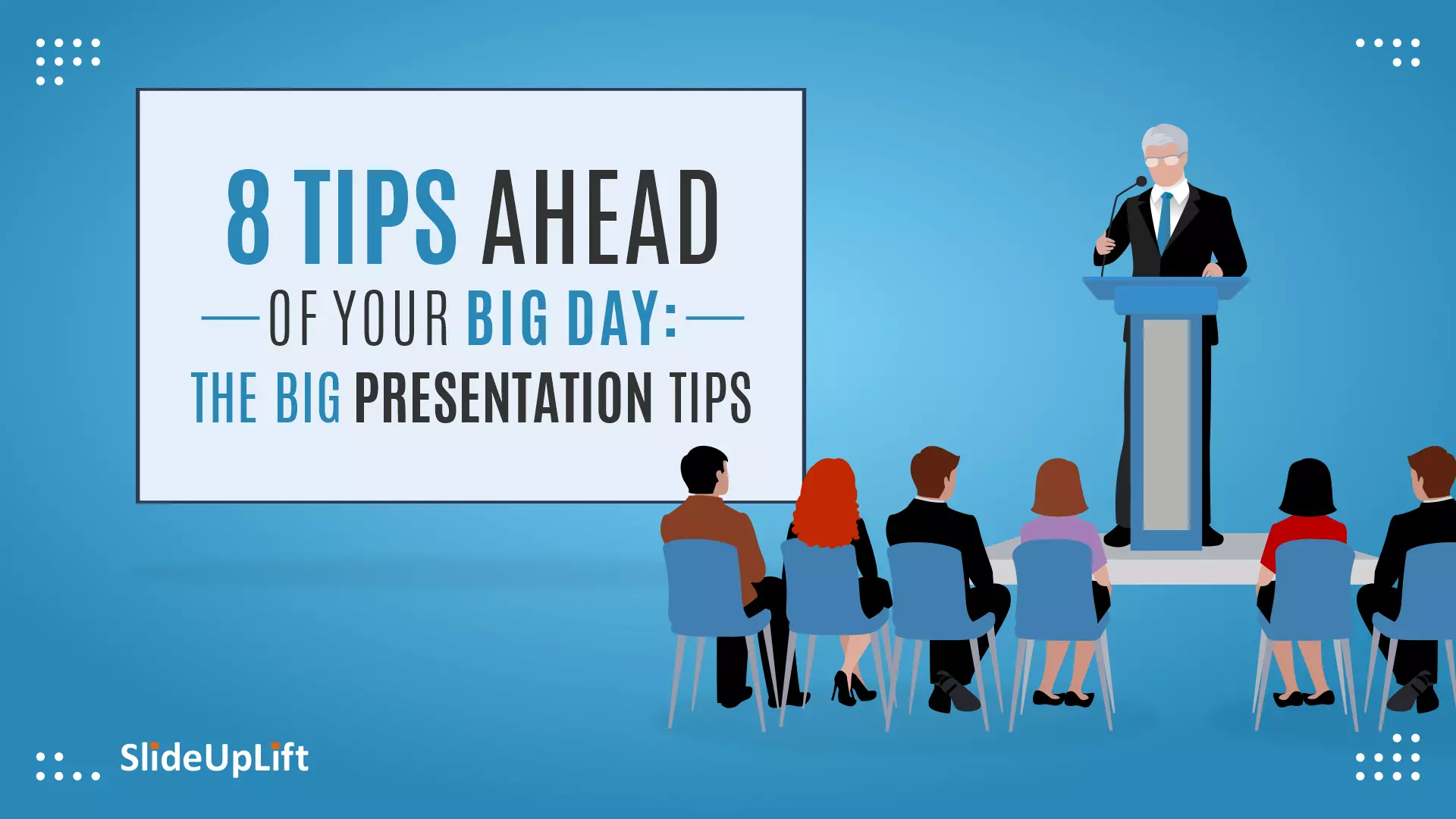
3 Feb, 2022 | SlideUpLift
8 Tips Ahead Of Your Big Day: The Big Presentation Tips
Are you preparing for your next big presentation? Aside from preparing, writing, and practicing your speech, there are certain other actions you should do to ensure you are truly prepared

1 Feb, 2022 | SlideUpLift
Powerful Words and Statements To Use In Presentations
No matter what industry you work in, you will have to deliver a presentation at some point. At first, this may be quite nerve-racking, if not simply terrifying. The good

2 Aug, 2021 | SlideUpLift
Public Speaking Demystified: Tips To Successful Workplace Communication
We live in a world where we are overwhelmed with content, and communicating information effectively to others is more important today than ever before. Public speaking is a great way
Forgot Password?
Privacy Overview
Necessary cookies are absolutely essential for the website to function properly. This category only includes cookies that ensures basic functionalities and security features of the website. These cookies do not store any personal information
Any cookies that may not be particularly necessary for the website to function and is used specifically to collect user personal data via ads, other embedded contents are termed as non-necessary cookies. It is mandatory to procure user consent prior to running these cookies on your website.
We use essential cookies to make Venngage work. By clicking “Accept All Cookies”, you agree to the storing of cookies on your device to enhance site navigation, analyze site usage, and assist in our marketing efforts.
Manage Cookies
Cookies and similar technologies collect certain information about how you’re using our website. Some of them are essential, and without them you wouldn’t be able to use Venngage. But others are optional, and you get to choose whether we use them or not.
Strictly Necessary Cookies
These cookies are always on, as they’re essential for making Venngage work, and making it safe. Without these cookies, services you’ve asked for can’t be provided.
Show cookie providers
- Google Login
Functionality Cookies
These cookies help us provide enhanced functionality and personalisation, and remember your settings. They may be set by us or by third party providers.
Performance Cookies
These cookies help us analyze how many people are using Venngage, where they come from and how they're using it. If you opt out of these cookies, we can’t get feedback to make Venngage better for you and all our users.
- Google Analytics
Targeting Cookies
These cookies are set by our advertising partners to track your activity and show you relevant Venngage ads on other sites as you browse the internet.
- Google Tag Manager
- Infographics
- Daily Infographics
- Popular Templates
- Accessibility
- Graphic Design
- Graphs and Charts
- Data Visualization
- Human Resources
- Beginner Guides
Blog Beginner Guides 9 Tips for Improving Your Presentation Skills For Your Next Meeting
9 Tips for Improving Your Presentation Skills For Your Next Meeting
Written by: Hannah Tow Feb 03, 2020

Presenting to an audience is one thing, but presenting ideas in a persuasive manner to the key stakeholders of your business is a whole other ball game.
The fact of the matter is that successfully presenting to a room full of people is a skill that’s mastered by very few. It takes practice, practice, and even more practice to start feeling comfortable with everyone’s eyes focused on you so you can effectively get your point across.
The reality of presenting is that you can’t escape it. Especially as you start to move up in your career. If you’re yearning to improve, this article will walk you through the top nine tips to use to enhance your presentation skills for your next big meeting as well as throughout your life. Let’s get started.

9 top tips for improving your presentation skills:
- Practice speaking in front of others
- Use less text and more visuals in your presentation
- Leverage your personality
- Welcome questions and comments during
- Be passionate and engaging
- Maintain eye contact with your audience
- Obsess over your listeners
- Focus on confident body language
- Keep it as short as possible
Constantly practicing, refining and improving upon your presentation skills will not only make you a more confident individual, but you will find that you rise quicker to success in your career. However, having great presentation skills does not just affect your work-life. Great presentation skills are truly life skills that you should integrate into more areas than just the conference room.
1. Practice speaking in front of others

Practice always makes perfect.
It doesn’t matter how well you know what you’re talking about, the moment you have to persuade, engage, or teach in front of an audience, you will probably stumble a bit. This is a natural reaction that affects pretty much everyone when all eyes are pointed in one direction and the anxiety sets in.
It’s important to remember that the overwhelming feeling of stress you probably feel is the result of your unfamiliarity with the situation, not from your lack of preparedness. The more comfortable you are with taking the stage and having everyone’s attention on you, the less nervous you’ll get.
The greater confidence you have in your presentation skills will allow you to focus on what actually matters–which is the material that you’re presenting.
The best way to implement this practice is by starting off small. Prepare a presentation to give to your friends, family, or closest co-workers. This sounds easy, but you will learn that it’s not necessarily who is listening to you that causes nerves, but it’s the fact that all of the attention is on you.
You’ll become more comfortable with the attention when you begin practicing in front of others more often, which will allow you to effectively present your ideas next time it’s your turn to speak in the conference room.
RELATED: Learn the top ten public speaking tips to better prepare you for your practice sessions.
2. Use less text and more visuals in your presentation

We’ve all been there before: sitting at the conference table trying our very best to stay interested and engaged with the presentation before us. The presentation lacks color, images, and all sense of creativity while containing an over-abundance of text and long-form paragraphs.
These types of presentations are horrible for two reasons:
The first reason being that the minute you have words on the screen, your audience will direct their attention away from you to begin reading and completely tune you out.
The second reason is if your presentation skills are poor, not only will your presentation be dull to listen to, but it will be unbelievably boring to look at as well. You’ll quickly find out how easy it is to lose most of the room’s attention when you create a lackluster presentation.
If you feel lost attempting to design your slides into an exciting work of art, try using creative presentation templates . PowerPoint templates make it simple to produce something beautiful, and they can also make you feel like an accomplished designer after seeing the outcome, such as this business presentation example .

In addition to nicely designed slides, you should always try to use infographics and charts to help you better summarize the complex information you’re relaying to your audience. It will be much easier for your listeners to understand what you’re explaining when they have something to visualize it with. Plus, there are plenty of resources out there to help you craft these visuals.
Learn how to make an infographic in five easy steps or produce an impressive graph .
If you feel worried that your presentation doesn’t hold enough content, you must remember the main reason for visual aids:
They are to enhance what you’re speaking about, not lead it!
If you’ve done enough practicing, you should feel confident in your presentation skills to thoroughly explain your main ideas and you won’t need to rely on the screen anyhow.
TIP: If you’re looking for even more ways to engage your audience with your visuals, check out 120+ presentation ideas that are sure to wow and delight!
3. Leverage your personality

As cliche as it sounds, you should always be true to who you are, especially if when you’re presenting.
It’s incredibly easy to tell if someone is faking it for the sake of their audience, so you should never pretend to act in a way that you don’t typically do. Not only will you feel unnatural and uncomfortable doing it, but you can also risk embarrassment when you try to tell a forced joke and no one laughs or your new-found trait of sarcasm doesn’t sit well with your boss.
It should bring you comfort knowing that most everyone in your meeting knows who you are. Use this to your advantage and start the presentation by playing up your best personality traits. Use your humor if you’re known to crack jokes or throw in your typical mannerisms.

These little additions will make your presentation feel much more relaxed for everyone involved. In addition to your own unique quirks, you should also bring a level of personability to your meeting.
Be empathetic, smile more, and look around the room. Doing so will improve your presentation skills, make you more likable, and allow your audience to be more receptive to you.
In many cases, you may be presenting virtually, rather than in person. You can still allow your personality to shine through and energize your virtual presentation. Lisa Schneider, Chief Growth Officer at Merriam-Webster, wrote for Venngage on how to adapt an in-person presentation into a virtual presentation . Check it out.
4. Welcome questions and comments during your presentation

Be flexible throughout your presentation. Answer questions and respond to any comments your audience may have either through hand raising or an audience response tool . Don’t worry if it veers you off your script. Chances are if one person has a question or comment, the others in the room are thinking it too.
Use this as an opportunity to prove how well you understand the material you’re presenting–your audience will take notice.
Also, take some time out at the start or your presentation to ask your audience some icebreaker questions and slowly transition into the more important stuff.
Taking this minute to talk through anything that your audience is thinking of is a good thing because it means they are engaged with you and really paying attention to the words coming out of your mouth. Doing so will also relax the format of your presentation, allowing you to feel more confident and relaxed as well.
5. Be passionate and engaging

When creating your presentation, craft it in such a way that makes your audience curious and makes them have questions for you. A persuasive presentation is the best way to get the positive reactions you are looking for, so be as passionate as you can be about your subject matter to seal the deal.
Remember that questions and comments during your presentation are a good thing, especially if you’re the one prompting them!
The more excited you are to present your ideas and show off your expertise, the more excited and engaged your audience will be. Own your subject matter and know what you’re talking about, it’s one of the most important presentation skills to have.
6. Maintain eye contact with your audience

This is a very obvious tip that will go a long way with your audience.
When the people you’re speaking to feel like you’re taking notice of them, they are much more likely to take notice of you and pay better attention to everything that you’re saying.
It’s important to remember that losing eye contact and looking everywhere but at the people that you’re presenting to is a common nervous behavior. Pay extra close attention to whether or not you’re guilty of that, and work to ensure you have your eyes on at least one person.
7. Obsess over your listeners

Be receptive to your listeners. You can’t forget that what you’re presenting is for the audience, and it has nothing to do about you!
Focus on the value you can provide to the people in the room. The more serving you are to them, the greater chance you have at driving your point home and nailing your presentation.
It’s also important not to forget about those listening to you remotely over video conferencing . Make sure they know you’re aware of them and engage them as well!
8. Focus on confident body language

Smiling, hand gestures, eye contact, and a powerful stance all exude confidence.
If you don’t have strong body language and are showing physical signs of nervousness (ie. tapping, bouncing, shaking, darting eyes, and more) your audience will have a hard time focusing on the material you’re presenting and hone in on the fact that you’re nervous and probably don’t know what you’re talking about as much as you say you do.
No matter how nervous you are, take a deep breath and pretend otherwise. You might actually start to believe it!
9. Keep it as short as possible

Every single person’s time is valuable ( especially at work), so don’t waste precious meeting time. If you can say everything you need to in half of the time that is allotted, you should do so.
Ensure that you’re only sharing the most important information. All of the extra fluff will bore your audience and you will lose their attention very quickly.
It’s a great idea to wrap up your presentation with key takeaways and action items. Doing so will ensure that no matter how quickly your meeting ended, your team understands their next steps. You can send out a quick, summarizing slide deck or an easy to read one-pager for their reference later. These visuals will make sure all of your bases are covered and that everyone is on the same page upon leaving the meeting.
A good presentation makes all the difference. Check out the top qualities of awesome presentations and learn all about how to make a good presentation to help you nail that captivating delivery.
Never stop refining your presentation skills
Possessing great presentation skills doesn’t come naturally to most people–it’s something that’s learned and practiced over time. As with most things in life, you must continuously work on refining your skills to get better and better.
Use these nine proven presentation tips that we covered in this article to improve your presentation skills and ace different presentation styles . By doing so, you will find that presenting at your key meetings becomes easier and easier and you’ll begin to nail it every single time.
More presentation guides:
How to Make a Persuasive Presentation
120+ Best Presentation Ideas, Design Tips & Examples
33 Presentation Templates and Design Tips to Hold Your Audience’s Attention
Presentation Design Guide: How to Summarize Information for Presentations
Discover popular designs

Infographic maker

Brochure maker

White paper online

Newsletter creator

Flyer maker

Timeline maker

Letterhead maker

Mind map maker

Ebook maker

- PERSONAL SKILLS
- Caring for Your Body
Personal Presentation
Search SkillsYouNeed:
Personal Skills:
- A - Z List of Personal Skills
- Personal Development
Check out our popular eBook now in its third edition.

The Skills You Need Guide to Life: Looking After Yourself
- Personal Skills for the Mind
- Emotional Intelligence
- Stress and Stress Management
- Anger and Aggression
- Assertiveness
- Living Well, Living Ethically
- Understanding Sustainability
- Measures of Wellness
- Wellness Testing and Tracking
- Positive Body Image
- Looking After Your Physical Health as a Teenager
- Self-Care For Teenagers
- Perimenopause and Health
- The Importance of Exercise
- Types of Exercise
- How to Exercise Safely and Effectively
- Top Tips for Exercising on a Budget
- Using Fitness Trackers to Exercise
- What is Sleep?
- The Importance of Sleep
- Food, Diet and Nutrition
- What is Protein?
- What are Carbohydrates?
- What is Sugar?
- Complex Carbohydrates, Sugars and Diet
- What is Fat?
- Cooking Fats and Oils
- What is Fibre?
- Dietary Minerals
- Vitamins - Nutrients Essential to Health
- Ultra-Processed Food
- Dietary Supplements
- Understanding and Improving Your Gut Microbiome
- Veganism and Plant-Based Diets
- Organic Food
- Debunking Some Food and Diet Myths
- Calorie Counting and Food Labelling
- Dieting for Weight Loss
- Body Mass Index - BMI Calculator
- Food Intolerances and Allergies
- Coffee and Health
- Alcohol and Health
Subscribe to our FREE newsletter and start improving your life in just 5 minutes a day.
You'll get our 5 free 'One Minute Life Skills' and our weekly newsletter.
We'll never share your email address and you can unsubscribe at any time.
Personal presentation is how you portray and present yourself to other people. It includes how you look, what you say, and what you do, and is all about marketing YOU, the brand that is you.
What others see and hear from you will influence their opinion of you. Good personal presentation is therefore about always showing yourself in the best possible light.
We all know that you only get one chance to make a first impression. Most of us are probably also aware that it takes quite a long time to undo that first impression—and that if it is negative, we may never get the chance to do so. This page explains some of the skills involved in making a good first impression—and then continuing to impress over time.

Understanding Personal Presentation
Personal presentation is about you and how you present yourself to others.
This includes both in everyday situations and when under pressure, for example, at job interviews. It is best thought of as a form of communication , because it always involves at least two people—the person presenting themselves (you) and the person seeing and hearing you.
Personal presentation covers what other people both see and hear. It includes how you look, what you say, and what you do. It therefore requires a wide range of skills, from improving your personal appearance to your communication skills.
However, all these aspects start from one place: you.
To present yourself well and confidently, you need to believe in yourself—or at least, be able to act as if you do.
Perception is Truth
People who present themselves as confident will be perceived as such by others.
There is also plenty of evidence that once we start acting as if we are confident, we generally feel more confident too.
Confidence—but not arrogance—is a very attractive trait. Having a justified belief in yourself and your abilities helps other people to be confident in you too.
Good personal presentation therefore requires good self-esteem and self-confidence. It means that you have to learn about yourself, and understand and accept who you are, both your positives and your negatives, and be comfortable with yourself. This does not, however, mean that you believe that there is nothing that you can improve—but that you are confident in your ability to achieve, and know how to overcome your flaws.
Paradoxically, therefore, personal presentation is actually not about being self-conscious or overly concerned with what others think about you. People who present themselves well generally do so because they believe in themselves, rather than because they are worried about what other people think. These concepts are closely related to Personal Empowerment .
A complete picture—and a cycle
Personal presentation is about conveying appropriate signals for the situation and for the other individuals involved.
People who lack self-esteem and confidence may fail to convey their message effectively or fully utilise their skills and abilities because of the way they present themselves. However, by improving your communication skills and reducing barriers to understanding, you may also improve your self-esteem and confidence.
Our pages: Communication Skills , Barriers to Communication and Improving Self-Esteem provide more information.
Areas of Personal Presentation
Improving personal presentation therefore requires a look at several different areas.
These include:
Self-esteem and self-confidence – how you feel about yourself and your abilities
Personal appearance – how you look, and how other people see you
Non-verbal communication – your body language, voice and facial expressions
Verbal communication – how you speak and use your words to make an impression
Behaviour – how you behave more generally, including politeness.
Self-Esteem and Self-Confidence
Self-esteem and self-confidence are closely related, but not quite the same thing.
Self-esteem is how you see and value yourself .
Self-confidence is believing in or having faith in your ability , rather than yourself as a person.
Neither self-esteem nor self-confidence are static. They vary as a result of numerous factors, including different situations and the presence of different people, personal stress levels and the level of change. Low levels of self-esteem are often associated with low levels of confidence, but those with good self-esteem can also suffer from low confidence.
To improve your self-esteem and self-confidence, spend time thinking about how you value yourself. Remind yourself of what is good about you, and learn to manage the highs and lows of self-esteem. In particular, try to avoid being affected too much by others’ opinions about you.
It is also worth practising coming across as confident even when you are not, because those who appear confident are not only perceived as confident, but often actually become more confident.
See our pages on Improving Self-Esteem and Building Confidence for more discussion, tips and advice on this area.
Personal Appearance and Non-Verbal Communication
Personal appearance is the way that you dress and take care of your general appearance.
Much as we may hate the idea that appearances matter, this is an important factor in personal presentation. Whether you like it or not, others will make judgements about you based on how you look, which includes how you dress and your accessories. It is therefore worth taking time to think about what messages you are sending to others in the way that you dress.
Case study: The ‘gravitas bag’
Louise was a young graduate, working in a government department. She had been working there about two years, and had just started working for a new boss, a woman just a few years older than her.
One day, on the way to an important meeting, Louise’s carrier bag, in which she was carrying her notebook and pens, broke on the bus. Her boss laughed, but said to her, carefully,
“ You know, you ought to think a bit about how what you wear and carry affects what people think about you. I’m not sure it gives quite the right impression to wander into a meeting with pens and books spilling out of a split carrier bag—that’s why I keep a briefcase in my cupboard for the days when I’ve worn a backpack into work. This may sound stupid, but I always feel that people may be judging me because I’m both female and quite young. I don’t want to give them any reason to doubt my professionalism. ”
Neither did Louise. The next weekend, she went shopping. On the Monday, she proudly showed her boss a new handbag and matching briefcase—her ‘gravitas bag’, as she described it.
Your personal appearance is closely related to the body language, gestures and other non-verbal messages that you use.
Many people are unaware of how they are affected by body language, and also how they are affecting others. By being aware of positive and negative non-verbal signals, you can improve your image and the way people perceive you.
There is more about these ideas in our pages on Personal Appearance and Non-Verbal Communication , including specific pages on Body Language and Face and Voice .
Verbal Communication and Effective Speaking
What you say and how you say it are both important aspects of how you are perceived by others.
Verbal communication is all about the words that you choose. Those who are good at verbal communication understand the impact of their particular choice of words and choose the right words for the situation and the audience. They are skilled at getting their message across to others and ensuring that it has been received.
See our pages on Verbal Communication for more.
Good communicators also use their voices effectively to convey their feelings, and to influence their audience. Your voice says a lot about you and learning how to use it more effectively has many benefits. There are a number of aspects to your voice, including accent, tone, pitch and volume. Some of these are easier to change than others, but it is worth thinking about how each of these affects your audience, so that you can learn to use your voice more effectively.
See our pages Effective Speaking and Non-Verbal Communication: Face and Voice to learn more.
How you behave, and not just how you speak, will leave a strong impression on others.
For example, if you are habitually late, you may give other people the impression that you do not value their time. Good time management skills can therefore be helpful in giving the right impression—as well as enabling you to work more efficiently.
See our pages Time Management and Avoiding Distractions for some ideas of to improve your time management skills.
More crucially, your general politeness—to everyone, and not just people who ‘matter’—will create an important impression about how you value others. This is an essential element of personal presentation. It pays to consider your manners.
See our page How to be Polite for more.

Further Reading from Skills You Need
Our Communication Skills eBooks
Learn more about the key communication skills you need to be a more effective communicator.
Our eBooks are ideal for anyone who wants to learn about or develop their interpersonal skills and are full of easy-to-follow, practical information.
And finally…
It is almost certainly impossible to overestimate the importance of personal presentation, especially in creating a good first impression, but also in giving a longer-term view of yourself.
Improving some fairly basic communication skills and increasing your self-awareness will improve your ability to present yourself well. Knowing that you are more likely to say and do the right things, and look the part, will help to increase your confidence. All these will, in turn, help to ensure that you give the right impression.
This is especially true in more formal situations, culminating in improved communication and therefore better understanding.
Continue to: Personal Appearance Self-Presentation in Presentations
See also: Effective Ways to Present Yourself Well Building a Personal Brand That Will Boost Your Career 8 Ways to Effectively Market Yourself as a Professional
1. Audience
Identify the communication preferences of the different personality types in your audience..
You will begin designing your presentation by thinking about what kinds of personality characteristics will likely be present in your audience. The Myers-Briggs personality type indicator is useful here. Write down a list of all the personality dimensions you expect to have represented in your audience: Extraverts, Introverts, or both? Detail-oriented people (Sensors), Conceptual types (Intuitors), or both? Feelers, Thinkers, or both? And Judgers (focused on closure), Perceivers (focused on exploration), or both? Whenever you are in doubt, default to “both,” so that you’ll have all bases covered.
Keep your list in front of you as you develop your presentation. If you are ready to move on, go to step 2: Objectives . Otherwise review the additional resources below if you need more assistance with this step.
Presentation implications of different personality characteristics
Introverts vs. extraverts
- Extraverts: be sure to allow lots of time for discussion; don’t bring more than 30 minutes of content to a one-hour meeting
- Introverts: provide some pre-reading because introverts need time to process data
- Both: do both – provide pre-reading to all (only the introverts will read it) and allow plenty of time for discussion
Sensors (detail-oriented) vs. Intuitors (conceptually-oriented)
- Sensors: provide all the necessary details, either in the presentation or in an appendix
- Intuitors (conceptually-oriented): provide the big picture
- Both: by designing your pages so that they pass the squint test , they will be attractive to both sensors, who will focus on the detail on each slide, and the intuitors, who will focus only on the conceptual layout of the slide
Feelers (people-oriented) vs. Thinkers (oriented towards things)
- Feelers: include all the relevant people implications
- Thinkers: include all the relevant costs and benefits
- Both: include both
Judgers (focused on reaching closure) vs. Perceivers (focused on exploring options)
- Judgers: tell them what your main recommendation is right up front
- Perceivers: let them know what alternatives you have considered
- Both: begin by listing the alternatives you have considered, and letting them know which one you are going to recommend
For more information on the Myers-Briggs personality type indicator, see the Myers & Briggs foundation .
For more details on any of the following, see Advanced Presentations by Design :
– How to estimate your audience’s personality types (p. 20)
– How to match your presentation design to different personality types (p. 21)
– What additional information to gather about your audience (p. 27)
Learn the Method
How would you like to learn the Extreme Presentation method?
- Presentation Fun Facts , Presentation Hacks
Presentation Skills for Each Personality Type
- By: Stephanie Fulton
We are a little obsessed with personality tests here at Ethos3. Okay, maybe really obsessed. We created our own personality test, the Badge assessment, modeled after the Myers-Briggs Type Indicator and Predictive Index . These tests can reveal aspects of your personality that not only help you feel closer to yourself, but also see where you can improve. Since we are pros at presentations, we have tips for how each personality type can improve their presentation skills.

First off, if you do not know your personality type, you can take this free test to find it out! After that, we hope you take our Badge assessment as well to discover your Presentation Persona. Then you will be on your way to mastering your presentation skills for an unforgettable event.
This personality type is reserved and intellectual. While this person will struggle to make connections with the audience, they are goal oriented and love competing ideas. This makes them great at developing the content for their presentation. The slides they write may be too heavy on the content side. Break them up so they are easier to understand. This person will also be to assuming of their audience when it comes to keeping up with their ideas. Use simple language and repetition to make sure everyone in the audience is on the same page.
Someone with this personality type is innovative and creative. They know how to build things with their hands, but don’t always know how to use their words. With some practice, this person can become an excellent speaker because they have a mind full of original ideas. Ask your family or friends to watch you present before you talk in front of a room of strangers. Get helpful feedback on your volume, body language and comfort level so you can improve these areas.
This person is a natural leader. ENTJs are driven to accomplish their dreams, and want to drive others to do the same. Because they believe deeply in their message, they over-prepare for their presentation. The content is rehearsed and the design is compelling. They can command the stage and deliver a passionate call to action. Where the ENTJ needs to improve is audience interaction. Take time to get to know the audience and answer their questions before and after the event. This will help you get others onboard with your message.
ENTPs love a challenge. This personality type loves to debate and make their points loud and clear. They can be hardheaded, which might turn off some audience members. Practice being more open to other’s ideas and reactions. Holding a Q & A session after the presentation will help your audience feel more involved with your great debate.
The INFJ is known for their moral compass. Their passion in life is to spread a message that will contribute to the greater good. This personality loves to help others and is very creative. Content and design development won’t be a problem. It’s public speaking part where this person will run into trouble. Because they are shy, the INFJ will not feel comfortable speaking in front of others or engaging with the audience. Understand that you are helping others with your message, so let your confidence shine. Get in front of a mirror and practice until you feel comfortable with the organization of your presentation.
Someone who is a INFP is a great storyteller. This personality is very intuitive and loves connecting with others. Interacting with the audience will be a breeze, as long as it’s a small crowd. Because they can make anything into a story, there’s not much time put into researching every angle of their presentation topic. This could lead to not knowing how to answer an audience member’s question. Take a few extra minutes to nail down the research before you present.
This is one charismatic and driven speaker. Like the ENTJ, the ENFJ is a natural leader who can rally up a crowd. People are pulled to this personality because of their confidence and optimism. This makes them an inspirational speaker who can spread a message far and wide. The biggest improvement this presenter can make is refining their message to fit each type of audience. Be aware of how long it takes you to deliver a presentation. If it’s more than 30 minutes, make sure you are giving your audience a break every 10 minutes.
This social butterfly is a lovable and friendly personality. People will enjoy watching the ENFP present because of how personable they are. They can make every audience member feel heard. Because the ENFP loves being social, they don’t focus too much on their message. This can cause their presentation to not have as big of an impact. Refine the core of the presentation message to ensure that it is understood.
ISTJs are hardworking people who like to play by the rules. They are guided through logic and practicality. They enjoying working alone and dedicating time to each task until it is complete. This makes the presentation content and design development enjoyable for them. It’s the “talking in front of others” part that is a challenge. Start with presenting your work in front of a small group of peers to get more comfortable with public speaking, and ask for feedback. Then, on the big day of the presentation, relax and open the floor up for discussion with your audience.
This personality type is very caring and devoted to helping others. ISFJs are soft spoken and humble, sometimes downplaying their accomplishments. They love to socialize but don’t like being noticed. This makes them feel uncomfortable with public speaking. By getting more comfortable with their message and audience, they can slowly build up the confidence they need. Let the power of your cause or product instill in you the passion and energy you need to perform.
ESTJs like to roll up their sleeves and lead the way. They have a gift of offering sound advice and guiding people through difficult situations. This personality is an energetic speaker. They enjoy traveling and sharing their message to all ages. Crafting your message with a thoughtful presentation design is a strong point. But realizing that not everyone will agree with that message is a downfall. This person does not react well when someone questions their ideas. Learn how to be understanding with your audience. Recognize that just because not everyone agrees with you does not mean you should abandon your calling.
This is a popular personality type. Think of the homecoming king and queen. They are well-liked by everyone and can draw a big crowd. This person is a people pleaser and is more caught up with appearances than principles. This trait makes them more likely to skip over the research needed for the presentation. Instead of focusing on the purpose of the presentation, they focus on holding people’s attention. The audience will enjoy watching, but will walk away without knowing anything new. Dedicate time to putting more thought into your presentation’s message and this will leave a bigger impact on your audience.
Like the INTP, this personality type likes to create new inventions. They would rather spend time figuring out how to build something themselves instead of asking others for help. The ISTP doesn’t mind having others watch them work, as long as no one gets in their way. This person is more methodical than creative. They can clearly and concisely explain a process step-by-step and they know how to answer any questions. But not much thought is put into the design or the interactions with the audience. Maybe teaming up with a designer will help solve that problem, and think of an activity for your audience like a poll question or ice breaker game.
This is an artistic personality with a keen eye for design. The look and feel of the presentation will come easily to the ISFP. Because they are introverted, they prefer to work alone where they are free to be themselves. But ISFPs have a vision for the world that they can present beautifully with their design ideas. Utilizing the help of a writer will be beneficial to the development of the content. With your message in place, your stunning designs will wow any audience.
The ESTP is the type of person who would volunteer themselves to do something instead of sitting on the sidelines. This person is creative, energetic and loves to talk. Public speaking is not a fear of theirs, but sitting down to do the research for their presentation is. The ESTP would rather improvise and entertain. This may keep audiences engaged, but will not teach them anything. Focus in on the point of the presentation and spread time mastering the message. Then you are ready to show off your presentation skills.
Similar to the ESTP, this personality type loves being the center of attention. They know how to keep an audience entertained and excited. While they may be able to bring the party, they do not have much enthusiasm for preparation. They would rather M.C. an event than present complicated data. Working with a team of writers and designers will help this person accomplish the goal and deliver an educational and energizing presentation.
Want to know more about your public speaking strengths and weaknesses? Take the Badge assessment to unlock your unique Presentation Persona. Our book What’s Your Presentation Persona? is filled with detailed methods for how to enhance your presentation skills with content development and design tips.
More from the Ethos3 blog:
How to Create an Audience-Focused Presentation
The Complete Guide to Editing Presentation Content
The Easiest and Most Effective Presentation Design Tip
Stephanie Fulton
Join our newsletter today.
© 2006-2024 Ethos3 – An Award Winning Presentation Design and Training Company ALL RIGHTS RESERVED
- Terms & Conditions
- Privacy Policy
- Diversity and Inclusion
- Bipolar Disorder
- Therapy Center
- When To See a Therapist
- Types of Therapy
- Best Online Therapy
- Best Couples Therapy
- Best Family Therapy
- Managing Stress
- Sleep and Dreaming
- Understanding Emotions
- Self-Improvement
- Healthy Relationships
- Student Resources
Personality Types
- Guided Meditations
- Verywell Mind Insights
- 2024 Verywell Mind 25
- Mental Health in the Classroom
- Editorial Process
- Meet Our Review Board
- Crisis Support
How Personality Impacts Our Daily Lives
Kendra Cherry, MS, is a psychosocial rehabilitation specialist, psychology educator, and author of the "Everything Psychology Book."
:max_bytes(150000):strip_icc():format(webp)/IMG_9791-89504ab694d54b66bbd72cb84ffb860e.jpg)
Verywell / Emily Roberts
Personality Characteristics
How personality develops, impact of personality, personality disorders.
Personality describes the unique patterns of thoughts, feelings, and behaviors that distinguish a person from others. A product of both biology and environment, it remains fairly consistent throughout life.
Examples of personality can be found in how we describe other people's traits. For instance, "She is generous, caring, and a bit of a perfectionist," or "They are loyal and protective of their friends."
The word "personality" stems from the Latin word persona , which refers to a theatrical mask worn by performers to play roles or disguise their identities.
Although there are many definitions of personality, most focus on the pattern of behaviors and characteristics that can help predict and explain a person's behavior.
Explanations for personality can focus on a variety of influences, ranging from genetic effects to the role of the environment and experience in shaping an individual's personality.
What exactly makes up a personality? Traits and patterns of thought and emotion play important roles, and so do these fundamental characteristics of personality:
- Consistency : There is generally a recognizable order and regularity to behaviors. Essentially, people act in the same way or in similar ways in a variety of situations.
- Both psychological and physiological : Personality is a psychological construct, but research suggests that it is also influenced by biological processes and needs.
- Affects behaviors and actions : Personality not only influences how we move and respond in our environment, but it also causes us to act in certain ways.
- Multiple expressions : Personality is displayed in more than just behavior. It can also be seen in our thoughts, feelings, close relationships, and other social interactions.
There are a number of theories about personality , and different schools of thought in psychology influence many of these theories. Some theories describe how personalities are expressed, and others focus more on how personality develops.
Type theories suggest that there are a limited number of personality types that are related to biological influences.
One theory suggests there are four types of personality. They are:
- Type A : Perfectionist, impatient, competitive, work-obsessed, achievement-oriented, aggressive, stressed
- Type B : Low stress, even- tempered , flexible, creative, adaptable to change, patient, tendency to procrastinate
- Type C : Highly conscientious, perfectionist, struggles to reveal emotions (positive and negative)
- Type D : Worrying, sad, irritable, pessimistic, negative self-talk, avoidance of social situations, lack of self-confidence, fear of rejection, appears gloomy, hopeless
There are other popular theories of personality types such as the Myers-Briggs theory. The Myers-Briggs Personality Type Indicator identifies a personality based on where someone is on four continuums: introversion-extraversion, sensing-intuition, thinking-feeling, and judging-perceiving.
After taking a Myers-Briggs personality test, you are assigned one of 16 personality types. Examples of these personality types are:
- ISTJ : Introverted, sensing, thinking, and judging. People with this personality type are logical and organized; they also tend to be judgmental.
- INFP : Introverted, intuitive, feeling, and perceiving. They tend to be idealists and sensitive to their feelings.
- ESTJ : Extroverted, sensing, thinking, and judging. They tend to be assertive and concerned with following the rules.
- ENFJ : Extroverted, intuitive, feeling, and judging. They are known as "givers" for being warm and loyal; they may also be overprotective.
Personality Tests
In addition to the MBTI, some of the most well-known personality inventories are:
- Minnesota Multiphasic Personality Inventory (MMPI)
- HEXACO Personality Inventory
- Caddell's 16PF Personality Questionnaire
- Enneagram Typology
Personality Traits
Trait theories tend to view personality as the result of internal characteristics that are genetically based and include:
- Agreeable : Cares about others, feels empathy, enjoys helping others
- Conscientiousness : High levels of thoughtfulness, good impulse control, goal-directed behaviors
- Eager-to-please : Accommodating, passive, and conforming
- Extraversion : Excitability, sociability, talkativeness, assertiveness, and high amounts of emotional expressiveness
- Introversion : Quiet, reserved
- Neuroticism : Experiences stress and dramatic shifts in mood, feels anxious, worries about different things, gets upset easily, struggles to bounce back after stressful events
- Openness : Very creative , open to trying new things, focuses on tackling new challenges
Try Our Free Personality Test
Our fast and free personality test can help give you an idea of your dominant personality traits and how they may influence your behaviors.
Psychodynamic Theories
Psychodynamic theories of personality are heavily influenced by the work of Sigmund Freud and emphasize the influence of the unconscious mind on personality. Psychodynamic theories include Sigmund Freud’s psychosexual stage theory and Erik Erikson’s stages of psychosocial development .
Behavioral Theories
Behavioral theories suggest that personality is a result of interaction between the individual and the environment. Behavioral theorists study observable and measurable behaviors, often ignoring the role of internal thoughts and feelings. Behavioral theorists include B.F. Skinner and John B. Watson .
Humanist theories emphasize the importance of free will and individual experience in developing a personality. Humanist theorists include Carl Rogers and Abraham Maslow .
Research on personality can yield fascinating insights into how personality develops and changes over the course of a lifetime. This research can also have important practical applications in the real world.
For example, people can use a personality assessment (also called a personality test or personality quiz) to learn more about themselves and their unique strengths, weaknesses, and preferences. Some assessments might look at how people rank on specific traits, such as whether they are high in extroversion , conscientiousness, or openness.
Other assessments might measure how specific aspects of personality change over time. Some assessments give people insight into how their personality affects many areas of their lives, including career, relationships, personal growth, and more.
Understanding your personality type can help you determine what career you might enjoy, how well you might perform in certain job roles, or how effective a form of psychotherapy could be for you.
Personality type can also have an impact on your health, including how often you visit the doctor and how you cope with stress. Researchers have found that certain personality characteristics may be linked to illness and health behaviors.
While personality determines what you think and how you behave, personality disorders are marked by thoughts and behavior that are disruptive and distressing in everyday life. Someone with a personality disorder may have trouble recognizing their condition because their symptoms are ingrained in their personality.
Personality disorders include paranoid personality disorder , schizoid personality disorder , antisocial personality disorder , borderline personality disorder (BPD), and narcissistic personality disorder (NPD).
While the symptoms of personality disorders vary based on the condition, some common signs include:
- Aggressive behavior
- Delusional thinking
- Distrust of others
- Flat emotions (no emotional range)
- Lack of interest in relationships
- Violating others' boundaries
Some people with BPD experience suicidal thoughts or behavior as well.
If you are having suicidal thoughts, contact the National Suicide Prevention Lifeline at 988 for support and assistance from a trained counselor. If you or a loved one are in immediate danger, call 911.
For more mental health resources, see our National Helpline Database .
If you are concerned that elements of your personality are contributing to stress, anxiety, confusion, or depression, it's important to talk to a doctor or mental health professional. They can help you understand any underlying conditions you may have.
It is often challenging to live with a personality disorder, but there are treatment options such as therapy and medication that can help.
Understanding the psychology of personality is much more than simply an academic exercise. The findings from personality research can have important applications in the world of medicine, health, business, economics, technology, among others. By building a better understanding of how personality works, we can look for new ways to improve both personal and public health.
The Myers & Briggs Foundation. MBTI basics .
Bornstein RF. Personality assessment in the diagnostic manuals: On mindfulness, multiple methods, and test score discontinuities . J Pers Assess . 2015;97(5):446-455. doi:10.1080/00223891.2015.1027346
Srivastava K, Das RC. Personality and health: Road to well-being . Ind Psychiatry J . 2015;24(1):1–4. doi:10.4103/0972-6748.160905
Mayo Clinic. Personality disorders .
Carducci BJ. The Psychology of Personality: Viewpoints, Research, and Applications . Wiley Blackwell.
John OP, Robins RW, Pervin LA. Handbook of Personality: Theory and Research . Guilford Press.
By Kendra Cherry, MSEd Kendra Cherry, MS, is a psychosocial rehabilitation specialist, psychology educator, and author of the "Everything Psychology Book."
Home Blog Presentation Ideas About Me Slides: How to Introduce Yourself in a Presentation
About Me Slides: How to Introduce Yourself in a Presentation

From conference talks to client demos, it’s always essential to include an About Me slide in any presentation you are giving. Introducing yourself early into the presentation helps build a better rapport with the audience.
You can start with several fun facts about me slide to break the ice or go for a more formal professional bio to explain your background and what makes you qualified to talk about the topic at hand. At any rate, your goal is to get the audience on your side by revealing some of your personality.
How to Introduce Yourself in a Presentation: 4 Approaches
It’s a good practice to include self-introduction slides at the beginning of your presentation. If you are looking to answer how to introduce yourself professionally, typically somewhere after the title, opening slide , and the main agenda. However, the presentation structure will be somewhat different depending on whether you are presenting to a new audience or a group of people familiar with (e.g., your team, clients, or business partners).
Here are four about me slide ideas you can try out, plus an About me template you can use to present yourself in a presentation.

1. Mention Your Name and Affiliations
Start with the introduction basics. State your name, company, title/position, and several quick facts about who you are and what you do. Even if you present to a familiar audience, a brief recap is always welcome.
To keep things a bit more engaging, consider adding some lesser-known facts about yourself. For example:
- Your interests
- Recent accomplishments
- Testimonial/quote from a team member
- Fun nicknames you got
The above can be nice ice breakers for less formal team presentations, project updates, or catch-ups with clients.
Here are several unique About Me examples you can try out:
For a client case study presentation :
“Hi, I’m Lynda, Chief Customer Success Specialist with Acme Corp. (Also, someone you thought was a chatbot for the first few encounters)
47 NPS | 15% Churn Rate | 40% repeat purchase rate”
For a team after-action review presentation :
Mike, Project Manager at Cool Project
(aka Maximizer)
Personal Project stats:
387 Slack messages answered
56 cups of coffee consumed
Project profit gross margin: $1.2 million
2. Work On Your Elevator Pitch
One of the best ways to introduce yourself in a presentation is to share a punchy elevator pitch. This works extra well if you are presenting to a new audience.
An elevator pitch is a concise statement (1-2 sentences) that summarizes your unique strengths, skills, and abilities and explains how these can benefit your listener.
It’s nice to have one ready for your presentations and networking in general since it helps you immediately connect with new people and communicate your value.
Writing a solid elevator pitch may require several attempts and iterations. But the sooner you start — the faster you’ll arrive at the best formula!
To get your creative juices flowing, here are several elevator pitch ideas you can incorporate in an introduction slide about yourself.
For professionals:
“Certified Salesforce Administrator, data visualization specialist, and analytics for top SaaS brands. I help businesses make more sense of their data to drive better outcomes”.
For a mentor :
“Adjunct professor of creative writing at Columbia University, published author, former lifestyle editor at Esquire, the New York Times. I can teach you how to find, shape, pitch, and publish stories for web & print.”
For a student:
“Third-year Marine Biology student at Denver State Uni. Volunteer at Lake Life Protection NGO, climate change activist, looking to expand my research about water conservation”.
3. Answer Popular Questions or Assumptions
If you are a frequent presenter , chances are you get asked a lot of the same “About Me questions” after your speeches and during the networking bits. So why not address a roaster of these in your About Me slide? Select 4-5 most common questions and list them as quick FAQs on your slide deck.
4. Focus on Telling a Story
Strong introductions are personable. They are meant to offer a sneak-peak into your personality and the passion behind your work. That’s why for less formal presentations, you can (and should!) start with a short personal story.
Remember: reliability is important to “click” with your audience.
For instance, neuroscience research of political ads recently found that ads featuring real people performed better than those with genetic stock footage. Among viewers, emotional engagement and memory encoding (recall) increased dramatically when political ads showed relatable people.
The same holds true for commerce. In 2015, GE launched a viral “What’s the Matter With Owen?” video ad series to attract more young talent to the company. The clips featured a relatable protagonist, struggling to explain what his work at GE entails e.g. that the company isn’t building railroads, but actually does some very innovative pilots. Many engineers related to the promo and work applications to GE shoot up by 800% !
As the above examples show, a good relatable story can go a long way. So think about how you can make a PowerPoint presentation about yourself more representative of who you really are as a person.
How to Give a Presentation About Yourself: 4 Fool-Proof Tips
On other occasions, you may be asked to give a full-length “about me” presentation. Typically, this is the case during a second interview, onboarding , or if you are in attending a training program or workshop where everyone needs to present themselves and their work.
Obviously, you’ll need more than one good about me slide in this case. So here’s how to prepare a superb presentation about me.
What to Put in a Presentation About Yourself?
The audience will expect to learn a mix of personal and professional facts about you. Thus, it’s a good idea to include the following information:
- Your name, contact info, website , social media handles, digital portfolio .
- Short bio or some interesting snippets.
- Career timeline (if applicable).
- Main achievements (preferably quantifiable).
- Education, special training.
- Digital badging awards , accolades, and other types of recognition.
- Something more personal — an interest, hobby, aspiration.
The above mix of items will change a bit, depending on whether you are giving an interview presentation about yourself or introduce yourself post-hiring. For example, in some cases a dedicated bio slide may be useful, but other times focusing on main achievements and goals can be better.
That being said, let’s take a closer look at how to organize the above information in a memorable presentation.
P.S. Grab an about me slide template to make the design process easier!

1. Create a List of “Facts About Me”
The easiest way to answer the “tell me about yourself” question is by having an array of facts you can easily fetch from your brain.
When it comes to a full-length about me presentation , it’s best to have a longer list ready. To keep your brainstorming process productive, organize all your ideas in the following buckets:
- Key skills (soft and hard)
- Educational accolades, training
- Accomplishments and other “bragging rights”
- Personal tidbits (a.k.a. fun facts )
Once you have a list, it gets easier to build a series of slides around it.
2. Think Like Your Audience
Most likely you’d be asked to make a presentation about yourself by a recruiter. There’s a good reason why many ask this — they want to determine if you are a good “cultural fit” for their organization.
After all, 33% of people quit within the first 3 months of accepting a new job. Among these:
- 43% of employees quit because their day-to-day role was different than what they were told it would be during the hiring process.
- 32% cite company culture as a factor for leaving within the first three months.
About me presentations often serve as an extra “filter” helping both parties ensure that they are on the same page expectations- and work style-wise. Thus, when you prepare your slide deck, do some background company research. Then try to align the presentation with it by matching the company tone, communication style, and cultural values.
3. Include Testimonials and Recommendations
Use the voice of others to back up the claims you are making in your presentation. After all, trumping your own horn is what you are expected to do in such a presentation. But the voices of others can strengthen the claims you are personally making.
Depending on your role and industry, try to sprinkle some of the following testimonials:
- LinkedIn recommendations
- Quotes from personal or professional references
- Social media comments
- Data metrics of your performance
- Funny assessments from your colleagues/friends
The above not just strengthen your narrative, but also help the audience learn some extras about you and your background. Testimonial slides can be of help for this purpose.
4. Include a Case Study
One of the best ways to illustrate who you are is to show what you are best in. Remember, an about me presentation often needs to “soft sell” your qualifications, experience, and personality.
One of the best ways to do that is to showcase how you can feel in a specific need and solve issues the business is facing.
So if you have the timeframe, use some of the ending slides to deliver a quick case study. You can present:
- Short retrospective of a past successful project
- Before-after transformations you’ve achieved
- Spotlight of the main accomplishments within the previous role
- Main customer results obtained
- Specific solution delivered by you (or the team you’ve worked with)
Ending your presentation on such a high note will leave the audience positively impressed and wondering what results you could achieve for them.
To Conclude
It’s easy to feel stumped when you are asked to talk about yourself. Because there are so many things you could mention (but not necessarily should). At the same time, you don’t want to make your introduction sound like a bragging context. So always think from the position of your audience. Do the facts you choose to share benefit them in any way? If yes, place them confidently on your About Me slides!
1. Personal Self Introduction PowerPoint Template

Use This Template
2. Self Introduction PowerPoint Template

3. Meet the Team PowerPoint Template Slides

4. Introduce Company Profile PowerPoint Template

5. Modern 1-Page Resume Template for PowerPoint

6. Modern Resume Presentation Template

Like this article? Please share
Introduce Yourself, Introduction, Presentation Ideas Filed under Presentation Ideas
Related Articles

Filed under Design , Presentation Ideas • May 1st, 2024
The Power of Mind Map Note Taking for Presenters
Add a new tool to your repertoire of presentation skills by mastering the art of mind map note taking. An ideal process to facilitate content retention.

Filed under Design • April 23rd, 2024
How to Create the Perfect Handouts for a Presentation
Learn how to create effective handouts for presentations and the recommended structure for handouts with this guide.

Filed under Presentation Ideas • February 15th, 2024
How to Create a 5 Minutes Presentation
Master the art of short-format speeches like the 5 minutes presentation with this article. Insights on content structure, audience engagement and more.
Leave a Reply
Rule the Room Train the Trainer
Become the Trainer Everyone Wants to Learn From
- Presentation Personality Quiz
Presentation Personality
- What best describes your personality? For each of the following 15 questions, select the answer that best describes how you think, feel, or behave on most days. Try to be honest, and don’t worry… There is no right or wrong!
- Someone known for making things easy to understand
- Sensitive and in tune to the needs of my listeners
- Known for amusing my audience
- Strong willed and unstoppable
- Full of insightful knowledge and facts
- Festive and entertaining
- Determined, motivated, and strong
- Someone with exceptional creativity
- Stand on my own and argue my beliefs with a crowd that doesn't agree with me
- Tell a humbling story about my life
- Get on stage and try to entertain a large audience
- Give personal advice to a group of strangers
- Provide sound advice and make it easy to understand
- Easily interpret the thoughts and feelings of others
- Confidently win almost any debate
- Generate laughter and make people feel at ease
- Administrative
- Entertaining
- Shares amazing insights and interesting details
- Seems to easily understand how I feel
- Fills the room with excitement and electricity
- Puts on an animated humorous show
- Call a close friend for a confidence boost and pep talk
- Tackle the causes of my anxiety immediately
- Take my mind off the situation by socializing with strangers
- Withdraw to a quiet place and analyze my concerns
- Entertaining, enjoyable, and fun to watch
- Strong, capable, and fearless
- Focused on facts and attention to detail
- Better connected to how the audience is feeling
- When they try to persuade or induce me to do something
- When they are weak, ineffectual or timid
- When they are swindling by means of confidence games
- When they are arrogant, self-assertive or conceited
- Enthusiastic
- Informative
- A powerful business person or an unstoppable athlete
- An intellectual genius that everyone seeks out
- A writer whose work deeply touches readers
- A successful actor or comedian
- Showing my expertise with remarkable attention to detail
- Surprising the audience with my witty humor
- Getting the sale and squashing the competition
- Sharing an important moment or conversation with an audience member
- Imaginative
- Unshakeable
- Funny and entertaining
- Smart, informative, and always giving me good advice
- Thoughtful and supportive with creative ideas
- Loyal, powerful, and always willing to back me up
- Confrontational
- Unpredictable
- Instructional Design
- Leadership Development
- Train the Trainer
- Learning Styles Quiz
- TTT Lab Sign In
- TTTHQ Sign In
- Jason Teteak: Rule the Room Train the Trainer

Pin It on Pinterest

Researched by Consultants from Top-Tier Management Companies

Powerpoint Templates
Icon Bundle
Kpi Dashboard
Professional
Business Plans
Swot Analysis
Gantt Chart
Business Proposal
Marketing Plan
Project Management
Business Case
Business Model
Cyber Security
Business PPT
Digital Marketing
Digital Transformation
Human Resources
Product Management
Artificial Intelligence
Company Profile
Acknowledgement PPT
PPT Presentation
Reports Brochures
One Page Pitch
Interview PPT
All Categories
Top 5 Personality Trait Templates with Examples and Samples

Samradni Pradhan
Have you ever wondered what makes you, you? Personality traits play a crucial role in shaping our thoughts, feelings, and behaviors. As the famous psychologist Gordon Allport once said, 'Personality is the dynamic organization within the individual of those psychophysical systems that determine his characteristic behavior and thought.' In fact, research suggests that personality traits can predict important outcomes such as job performance, academic success, and mental health.
Did you know that there are over 18,000 adjectives in the English language that describe personality traits? With so many options, it can be overwhelming to pinpoint the traits that best describe yourself or others. That's where personality traits templates come in. These templates provide a structured and concise way to identify and describe personality traits, making it easier to communicate about ourselves and understand others.
Best Personality Traits Templates
SlideTeam offers a collection of templates that are designed to help individuals and organizations describe and analyze personality traits. These templates are highly regarded and widely used by business leaders around the world.
The templates are based on research and theories of personality psychology and provide a structured way to identify and describe personality traits that are relevant to business contexts, such as leadership, teamwork, and communication skills.
Let’s explore these content-ready editable templates!
Template 1: Qualities and Personality Traits PPT slide
This template features a human silhouette with speech bubble-like elements that can be personalized to showcase a variety of unique personality traits, like being thoughtful, responsible, having a sense of humor, someone who plays well with others, being hard-working, and being grounded. With eye-catching graphics and editable text placeholders, you can easily create a fun and engaging presentation highlighting individuality and self-expression's importance. Download now!
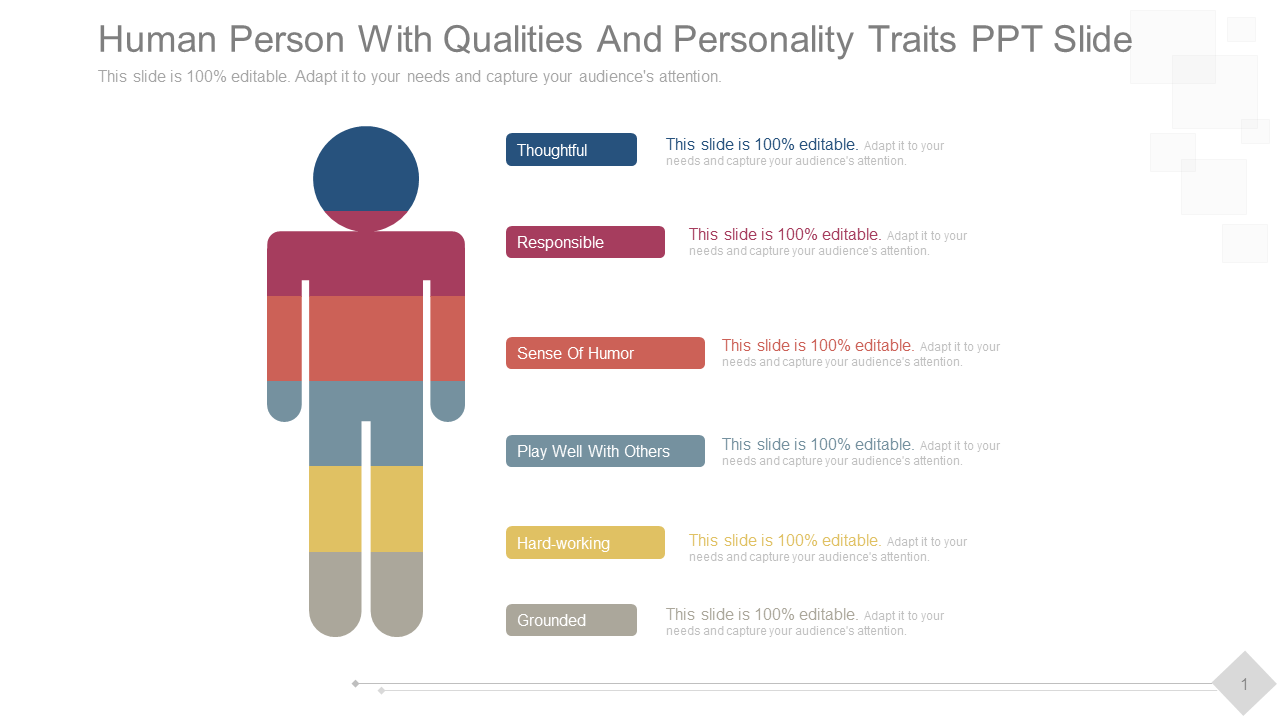
Download Now!
Template 2: Brand Archetype Personality Traits with Four Categories
This quirky and unique template features four categories of personality traits that align with your brand archetype, including "The Creator," "The Explorer," "The Rebel," and "The Sage." Whether you're a bold and daring rebel or a wise and knowledgeable sage, this template is the perfect tool to create a memorable and impactful presentation that showcases your brand's personality.
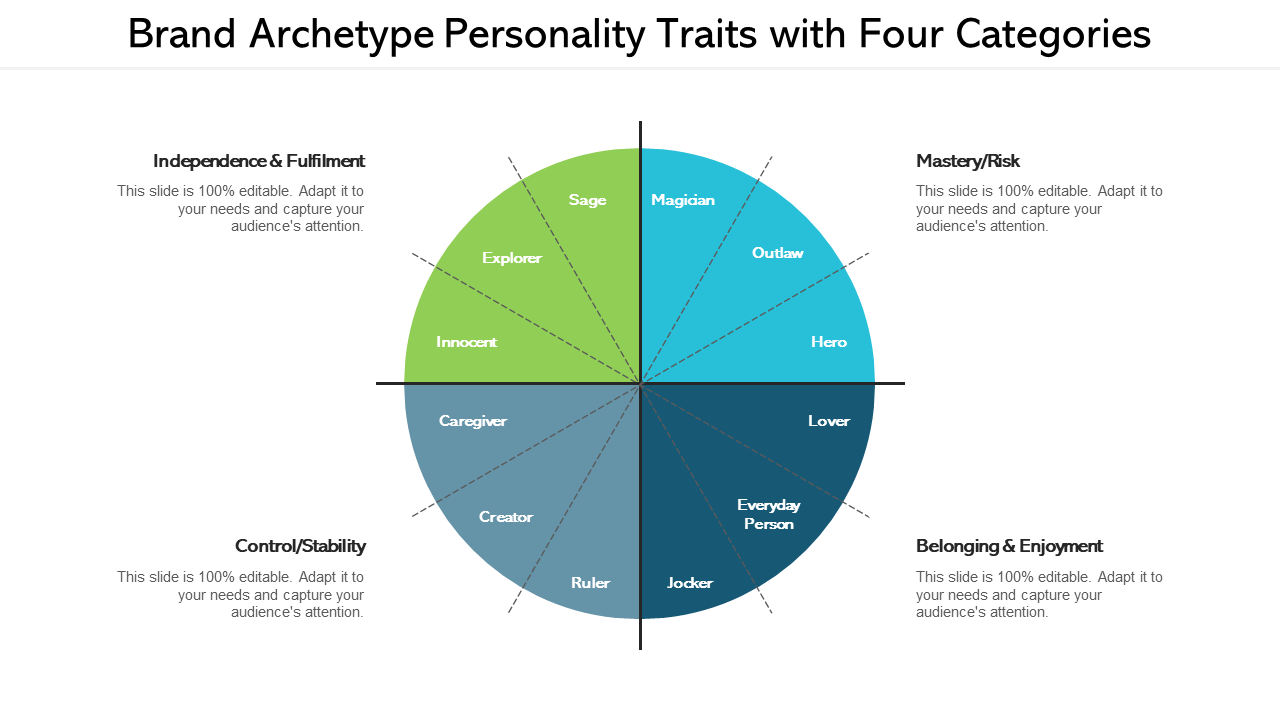
Template 3: Five Key Points Illustrating Individual Personality Traits
This amazing PPT Template features customizable text boxes and visually stunning graphics that allow you to showcase the individual personality traits that make you or your team members unique. Whether you're highlighting conscientiousness, agreeableness, openness, extraversion, neuroticism, or any other personality trait, this template is the perfect tool to create an engaging and impactful presentation that captures your audience's attention. With easy-to-edit text and vibrant graphics, you can create a one-of-a-kind presentation that celebrates individuality and promotes the importance of embracing our unique personalities. So, showcase your personality through our template today!
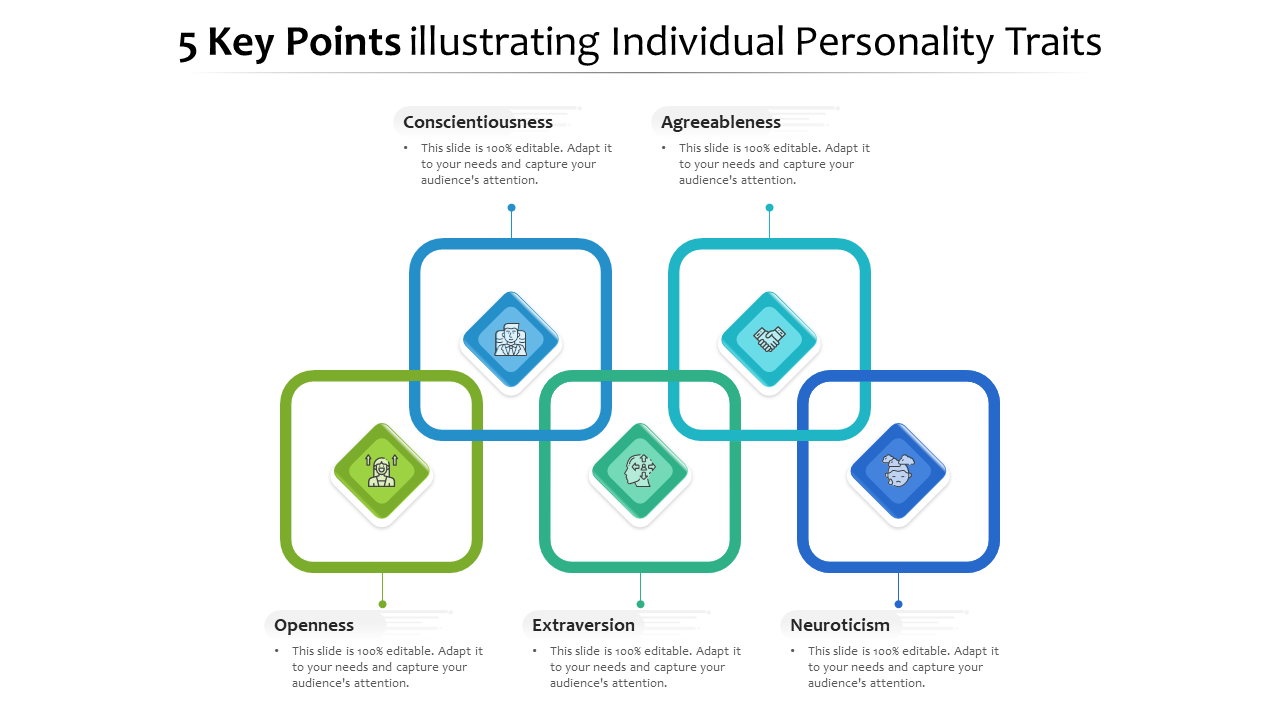
Template 4: Personality Traits or Factor Model for Employee Traits
This unique template features customizable graphics in the shape of a human face/brain and allows you to highlight personality traits in a foolproof manner. With a focus on multiple personality traits, this template is the right tool for creating a fun and engaging presentation that celebrates individuality in the workplace. Bring some personality to your next presentation by downloading this quirky template!
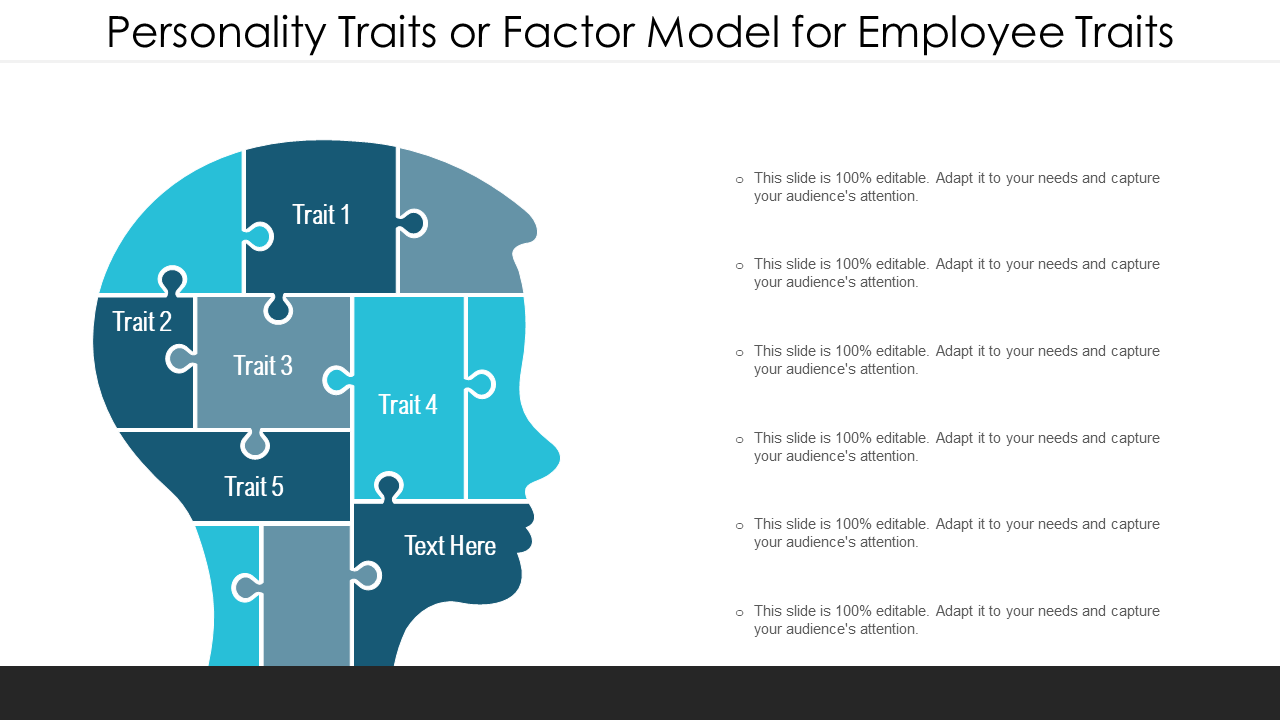
Template 5: Business Idea Marketing Leadership Personality Traits
Are you looking out for a way to showcase your business idea while highlighting your leadership and marketing skills? Our template is here to help! With a focus on creativity, innovation, and strategic thinking, this template is the perfect tool to create a memorable and impactful presentation that highlights your strong points and sets you apart from the competition. Additionally, it includes stunning graphics that literally make all the difference. Go ahead and download this template today!
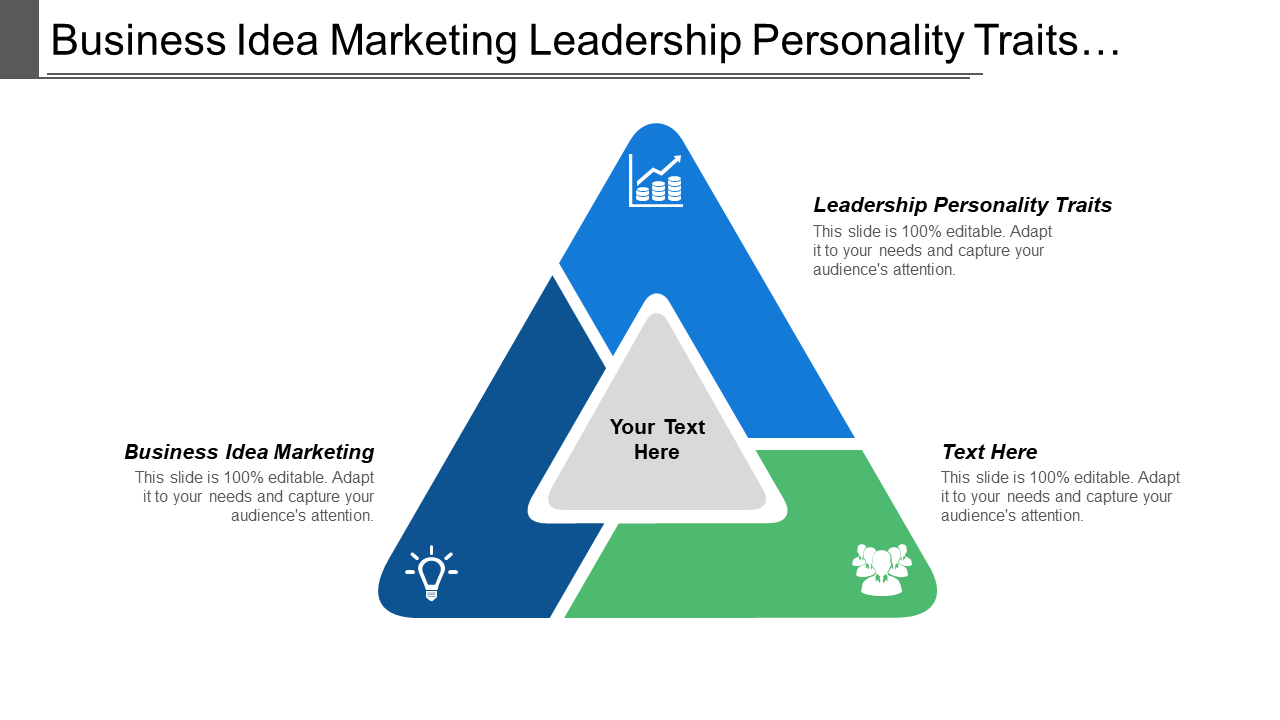
Template 6: Personality Traits Template
Showcase the unique qualities that make you or your team members stand out with our template! This one-of-a-kind template features customizable text boxes and visually stunning graphics that allow you to highlight the individual personality traits that make you or your team members unique. With this template added to your deck, you really need nothing more to ramp up your presentation. Download it right away!

Template 7: DISC Matrix Icon to Assess Personality Traits
Our DISC Matrix Template features customizable graphics and text boxes that allow you to showcase the four main personality traits - Dominance, Influence, Steadiness, and Conscientiousness. With visually stunning graphics and easy-to-edit text, you can create a fun and engaging presentation that promotes the importance of understanding unique personality traits. Whether you're using it for personal development or team-building exercises, this template is the perfect tool to assess and celebrate individuality. Go ahead and grab this template today!
EXPLORE THESE PERSONALITY TRAIT TEMPLATES TODAY!
A well-designed PowerPoint presentation can make all the major difference in delivering an impactful message to your audience. Incorporating personality trait templates into your presentations allows you to effectively communicate your ideas while keeping your audience engaged and interested.
The top Personality Trait PowerPoint Templates highlighted in this blog provide a wide range of options, each with unique features and benefits. Whether you're creating a presentation for business, education, or individual use, these templates can help you make a lasting impression. Explore these templates, customize them to suit your needs, and take your presentations to the next level.
Download these premium PPT Slides through our monthly, semi-annual, annual, annual + custom design subscriptions here .
FAQs on Personality Traits
What are the five personality traits.
The five broad personality traits, known as the "big five" or otherwise referred to as Five-Factor Model (FFM) are:
- Openness To Experience- It reflects an individual's intellectual curiosity, imagination, creativity, and exposure to new ideas, values, and experiences.
- Conscientiousness reflects a person's reliability, responsibility, organization, self-discipline, and goal orientation.
- Extraversion is the sociability, assertiveness, energy level, positive emotionality, and enjoyment of stimulation and social interactions in a person.
- Agreeableness- A person tends to be cooperative, empathetic, and kind.
- Neuroticism- This trait refers to a person's emotional stability and sensitivity to stress.
What are the seven big personality traits?
There are different models and theories of personality, but the most widely recognized and researched model is the Five-Factor Model (FFM), which includes five broad dimensions of traits. However, some psychologists have proposed additional personality traits that complement or expand the FFM. Here are the two additional big personality traits along with
- Honesty-Humility is a person's sincerity, modesty, fairness, and lack of greed or arrogance.
- Impulsivity- This trait reflects a person's tendency to act without forethought, to seek immediate gratification, and to take risks without considering the consequences.
However, it is imperative to understand that the FFM model is just one of many personality systems and that personality traits are complex and multifaceted.
What are the four main personality traits?
The four main personality traits are often referred to as the "DISC" personality system,
which stands for:
- Dominance- A person tends to take charge, be assertive, and strive for control over their environment and others.
- Influence- This trait refers to a person's sociability, persuasiveness, and ability to build relationships and inspire others.
- Steadiness- It determines a person's calmness, stability, and loyalty, as well as their preference for routine and predictability.
- Conscientiousness is a personality of detail-oriented, responsible, and structured order in a person.
The DISC model is often used in workplace and leadership contexts to help individuals and teams better understand their own and others' personality styles and communication preferences.
What are examples of good personality traits?
Good personality traits contribute positively to a person's well-being and social functioning, as well as to well-being and social functioning. Here are some examples of good personality traits:
- Responsibility.
- Open-mindedness.
- Resilience.
Related posts:
- Top 10 Software Cover Letter Templates with Samples and Examples
- 40 Best Lego Blocks PowerPoint Templates To Unlock Your Hidden Talent
- [Updated 2023] Top 25 Brainstorming PowerPoint Templates for Stimulating Out-of-the-box Thinking!
- [Updated 2023] Top 20 Coaching and Mentoring Templates in PowerPoint for Leadership Development
Liked this blog? Please recommend us

The Ultimate Guide to Project Management Excellence: The Playbook PowerPoint Template

Top 10 Brand Plan Templates with Samples and Examples
This form is protected by reCAPTCHA - the Google Privacy Policy and Terms of Service apply.

Digital revolution powerpoint presentation slides

Sales funnel results presentation layouts
3d men joinning circular jigsaw puzzles ppt graphics icons

Business Strategic Planning Template For Organizations Powerpoint Presentation Slides

Future plan powerpoint template slide

Project Management Team Powerpoint Presentation Slides

Brand marketing powerpoint presentation slides

Launching a new service powerpoint presentation with slides go to market

Agenda powerpoint slide show

Four key metrics donut chart with percentage

Engineering and technology ppt inspiration example introduction continuous process improvement

Meet our team representing in circular format


IMAGES
VIDEO
COMMENTS
A successful actor or comedian. My idea of a successful presentation would likely include:*. Showing my expertise with remarkable attention to detail. Surprising the audience with my witty humor. Getting the sale and squashing the competition. Sharing an important moment or conversation with an audience member.
Discovering your Presentation Personality is the first step to becoming a more genuine, more authentic public speaker. Once you know your style, you can leverage the techniques and traits above to keep your audience engaged, and have them feeling safe with you as a presenter.
Here are a few tips for business professionals who want to move from being good speakers to great ones: be concise (the fewer words, the better); never use bullet points (photos and images paired ...
Interactive elements enhance audience engagement during the presentation. Based on personality types, different types of interactions can have varying impacts on your audience. Analytical types may benefit from question-and-answer rounds or discussions, while socially-oriented listeners may respond well to group activities or partner exercises.
Personality in a presentation - On the contrary, with her calm, soft character, Susan Cain gently empowers and inspires introverted people. 2. Tell your own stories. Personality in a presentation. The speaker's credibility is what impresses the audience the most, and a simple way to improve this is to tell stories of your own experience.
Presentation Styles are the public speaking techniques that an individual uses when he or she delivers a speech. ... Hippocrates was the first philosopher/doctor to present a theory about personality temperaments. He claimed that there were four main personality styles. In fact, there are hundreds of modern-day books and studies based on this ...
Your personality naturally influences how you approach a task, such as presenting in front of an audience. To ensure that your presentation runs smoothly, you must first identify what type of presenter you are. We've prepared a list of 10 distinct types of presenters, so figure out which one you are and get ready to deliver a compelling ...
Presentation skills are the abilities and qualities necessary for creating and delivering a compelling presentation that effectively communicates information and ideas. They encompass what you say, how you structure it, and the materials you include to support what you say, such as slides, videos, or images. You'll make presentations at various ...
9 top tips for improving your presentation skills: Practice speaking in front of others. Use less text and more visuals in your presentation. Leverage your personality. Welcome questions and comments during. Be passionate and engaging. Maintain eye contact with your audience. Obsess over your listeners. Focus on confident body language.
Personal presentation covers what other people both see and hear. It includes how you look, what you say, and what you do. It therefore requires a wide range of skills, from improving your personal appearance to your communication skills. However, all these aspects start from one place: you. To present yourself well and confidently, you need to ...
Presentation implications of different personality characteristics. Introverts vs. extraverts. Extraverts: be sure to allow lots of time for discussion; don't bring more than 30 minutes of content to a one-hour meeting. Introverts: provide some pre-reading because introverts need time to process data. Both: do both - provide pre-reading to ...
Whatever presentation you're giving, try to make it reflect the company or organization's values, mission and communication style. While you can create your presentation to reflect your personality, be mindful of the company's brand and mission and try to emulate them in your delivery. Related: 10 Tips for Giving a Great Presentation 2.
The Architect (INTJ) INTJ stands for Introversion, Intuition, Thinking and Judgment. This is one of the rarest personality types and relies mostly on logical reasoning to achieve desired goals. The personality type is estimated to be 2% of the population. INTJs can be quite idealistic and cynical at the same time.
INTJ. This personality type is reserved and intellectual. While this person will struggle to make connections with the audience, they are goal oriented and love competing ideas. This makes them great at developing the content for their presentation. The slides they write may be too heavy on the content side.
Personality - Download as a PDF or view online for free. 5. Characteristics Personality is an internal process that guides behaviour. Gordon Allport (1961) makes the point that personality is psychophysical, which means both physical and psychological. Biological and genetic phenomena do have an impact on personality. Child (1968) makes the point that personality is stable - or at least ...
A great way to kick off the introduction to your creative self-introduction PPT is to tie yourself to the topic and then tie the topic to the audience. Start by stating your name and job title and then share a random or a fun fact about you. Then, transition into the main part of your presentation about yourself. 4.
Type theories suggest that there are a limited number of personality types that are related to biological influences. One theory suggests there are four types of personality. They are: Type A: Perfectionist, impatient, competitive, work-obsessed, achievement-oriented, aggressive, stressed. Type B: Low stress, even- tempered, flexible, creative ...
ESFP-A / ESFP-T. Spontaneous, energetic and enthusiastic people - life is never boring around them. Extensive, research-backed profiles of 16 personality types: learn how different personalities approach romantic relationships, career choices, friendships, parenthood, and more.
Self Introduction PowerPoint Template by SlideModel. 1. Create a List of "Facts About Me". The easiest way to answer the "tell me about yourself" question is by having an array of facts you can easily fetch from your brain. When it comes to a full-length about me presentation, it's best to have a longer list ready.
Personality. Personality refers to the enduring characteristics and behavior that comprise a person's unique adjustment to life, including major traits, interests, drives, values, self-concept, abilities, and emotional patterns. Various theories explain the structure and development of personality in different ways, but all agree that ...
Sensitive and in tune to the needs of my listeners. Known for amusing my audience. Strong willed and unstoppable. Those who know me best would most likely describe me as being: *. Full of insightful knowledge and facts. Festive and entertaining. Determined, motivated, and strong. Someone with exceptional creativity.
of things, people, and events and. 2.The inner world of our own thoughts, feelings, and reflections. Jung's Personality Theory. • Each person has a preference for either the outer world or the inner world. Jung's Personality Theory. Jung believed that preferences are innate— "inborn predispositions". He also recognized that they are ...
Template 1: Qualities and Personality Traits PPT slide. This template features a human silhouette with speech bubble-like elements that can be personalized to showcase a variety of unique personality traits, like being thoughtful, responsible, having a sense of humor, someone who plays well with others, being hard-working, and being grounded.